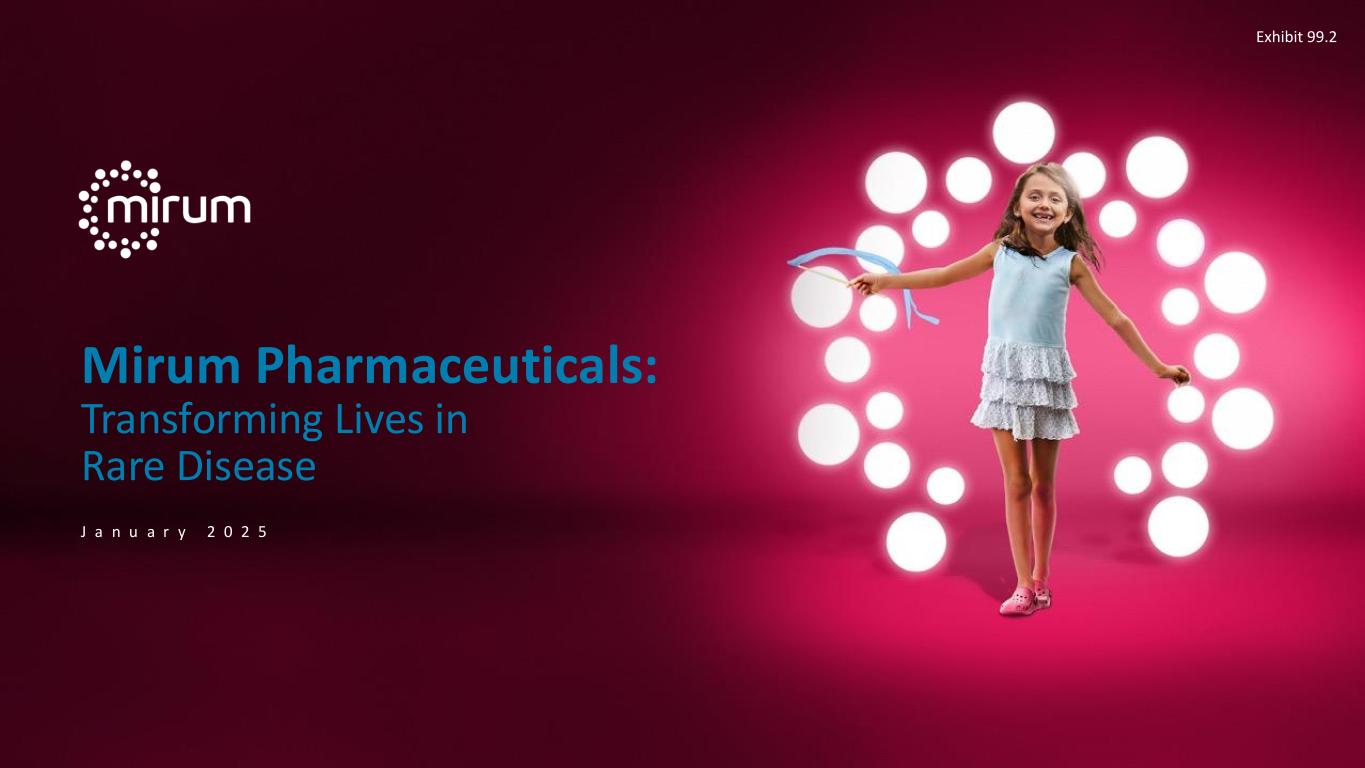
J a n u a r y 2 0 2 5 Mirum Pharmaceuticals: Transforming Lives in Rare Disease Exhibit 99.2
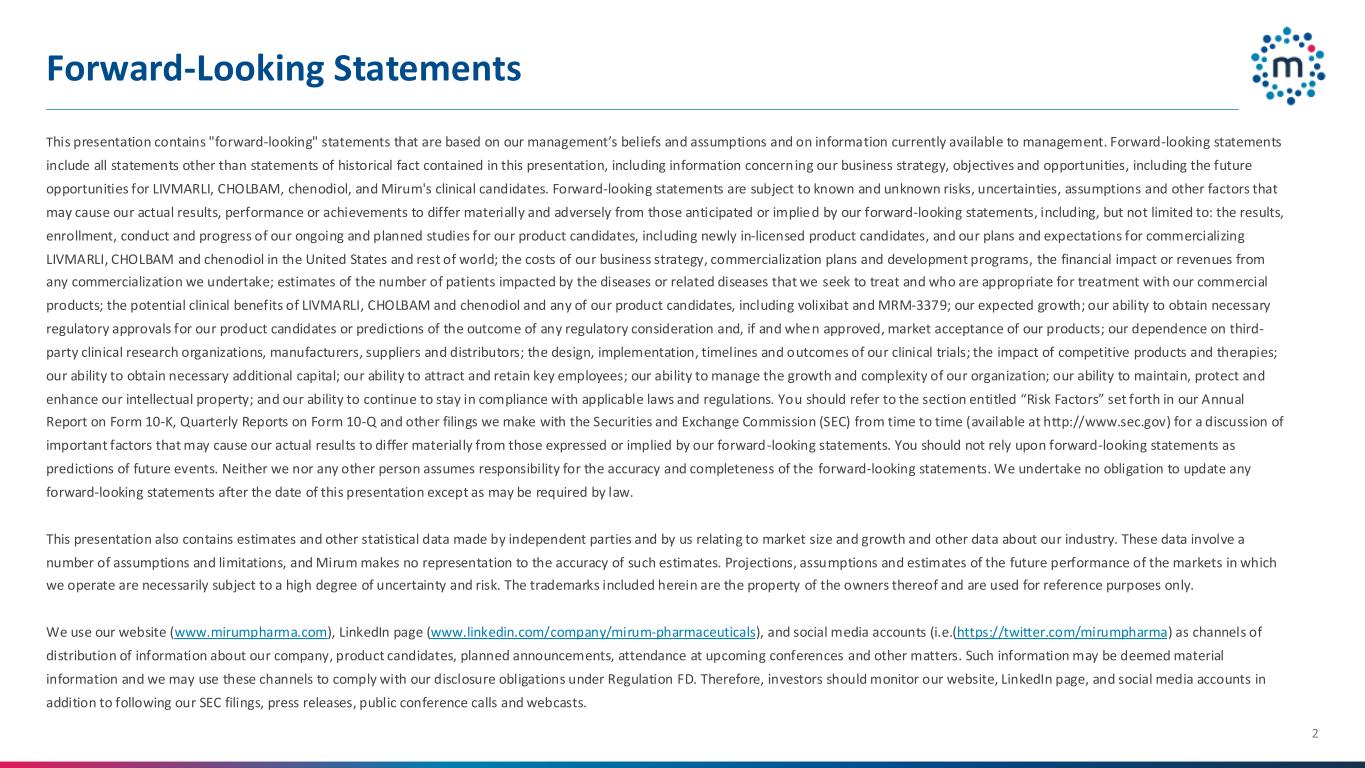
Forward-Looking Statements This presentation contains "forward-looking" statements that are based on our management’s beliefs and assumptions and on information currently available to management. Forward-looking statements include all statements other than statements of historical fact contained in this presentation, including information concerning our business strategy, objectives and opportunities, including the future opportunities for LIVMARLI, CHOLBAM, chenodiol, and Mirum's clinical candidates. Forward-looking statements are subject to known and unknown risks, uncertainties, assumptions and other factors that may cause our actual results, performance or achievements to differ materially and adversely from those anticipated or implied by our forward-looking statements, including, but not limited to: the results, enrollment, conduct and progress of our ongoing and planned studies for our product candidates, including newly in-licensed product candidates, and our plans and expectations for commercializing LIVMARLI, CHOLBAM and chenodiol in the United States and rest of world; the costs of our business strategy, commercialization plans and development programs, the financial impact or revenues from any commercialization we undertake; estimates of the number of patients impacted by the diseases or related diseases that we seek to treat and who are appropriate for treatment with our commercial products; the potential clinical benefits of LIVMARLI, CHOLBAM and chenodiol and any of our product candidates, including volixibat and MRM-3379; our expected growth; our ability to obtain necessary regulatory approvals for our product candidates or predictions of the outcome of any regulatory consideration and, if and when approved, market acceptance of our products; our dependence on third- party clinical research organizations, manufacturers, suppliers and distributors; the design, implementation, timelines and outcomes of our clinical trials; the impact of competitive products and therapies; our ability to obtain necessary additional capital; our ability to attract and retain key employees; our ability to manage the growth and complexity of our organization; our ability to maintain, protect and enhance our intellectual property; and our ability to continue to stay in compliance with applicable laws and regulations. You should refer to the section entitled “Risk Factors” set forth in our Annual Report on Form 10-K, Quarterly Reports on Form 10-Q and other filings we make with the Securities and Exchange Commission (SEC) from time to time (available at http://www.sec.gov) for a discussion of important factors that may cause our actual results to differ materially from those expressed or implied by our forward-looking statements. You should not rely upon forward-looking statements as predictions of future events. Neither we nor any other person assumes responsibility for the accuracy and completeness of the forward-looking statements. We undertake no obligation to update any forward-looking statements after the date of this presentation except as may be required by law. This presentation also contains estimates and other statistical data made by independent parties and by us relating to market size and growth and other data about our industry. These data involve a number of assumptions and limitations, and Mirum makes no representation to the accuracy of such estimates. Projections, assumptions and estimates of the future performance of the markets in which we operate are necessarily subject to a high degree of uncertainty and risk. The trademarks included herein are the property of the owners thereof and are used for reference purposes only. We use our website (www.mirumpharma.com), LinkedIn page (www.linkedin.com/company/mirum-pharmaceuticals), and social media accounts (i.e.(https://twitter.com/mirumpharma) as channels of distribution of information about our company, product candidates, planned announcements, attendance at upcoming conferences and other matters. Such information may be deemed material information and we may use these channels to comply with our disclosure obligations under Regulation FD. Therefore, investors should monitor our website, LinkedIn page, and social media accounts in addition to following our SEC filings, press releases, public conference calls and webcasts. 2
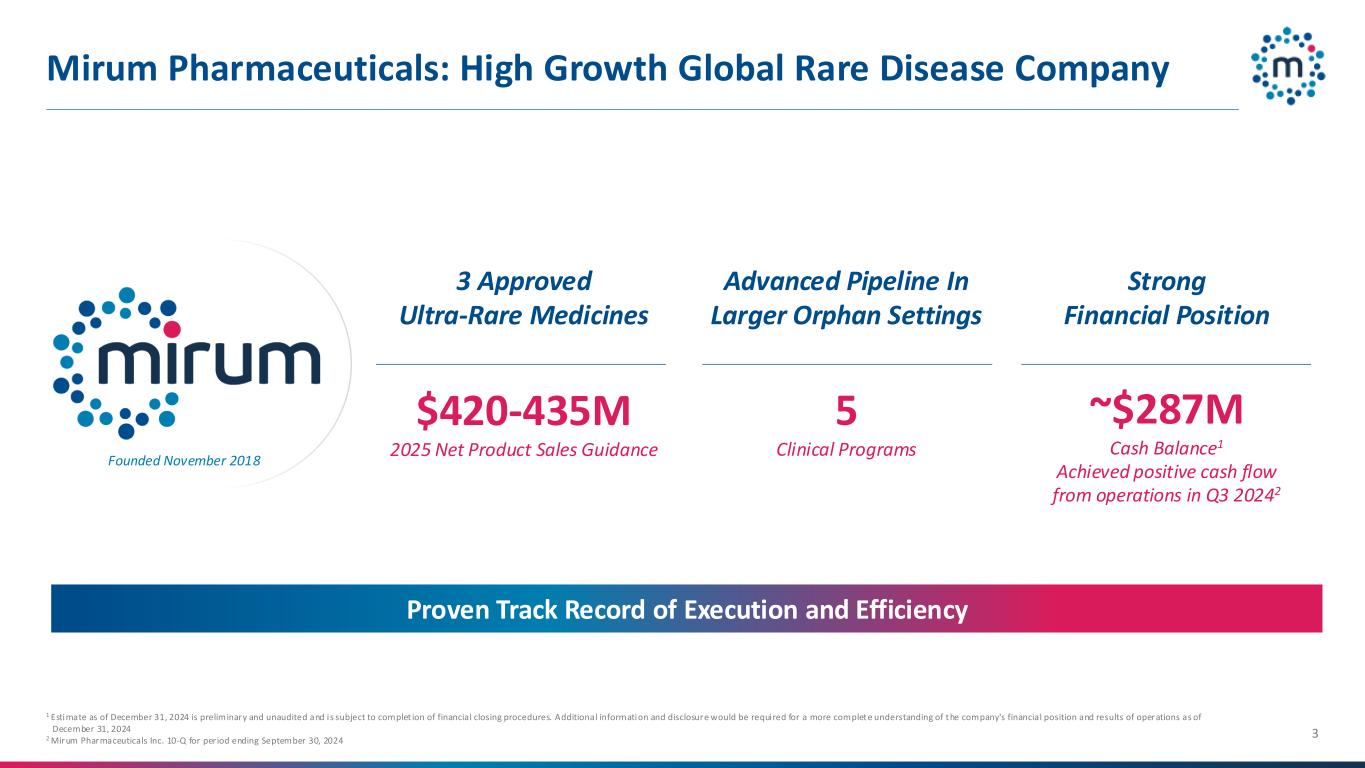
Mirum Pharmaceuticals: High Growth Global Rare Disease Company 3 Proven Track Record of Execution and Efficiency 1 Estimate as of December 31, 2024 is preliminary and unaudited and is subject to complet ion of financial closing procedures. Additional information and disclosure would be required for a more complete understanding of the company's financial position and results of operations as of December 31, 2024 2 Mirum Pharmaceuticals Inc. 10-Q for period ending September 30, 2024 $420-435M 2025 Net Product Sales Guidance 3 Approved Ultra-Rare Medicines Advanced Pipeline In Larger Orphan Settings 5 Clinical Programs Strong Financial Position ~$287M Cash Balance1 Achieved positive cash flow from operations in Q3 20242 Founded November 2018
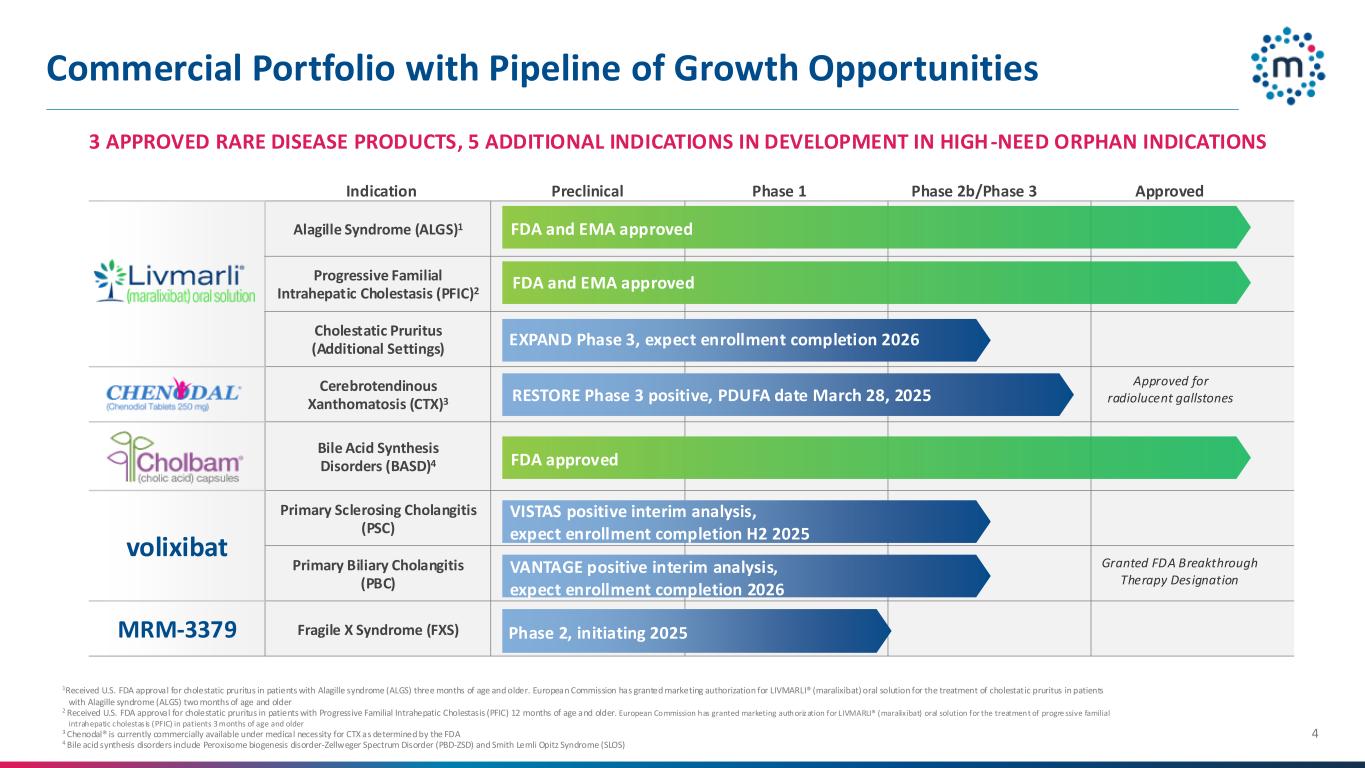
Commercial Portfolio with Pipeline of Growth Opportunities 1Received U.S. FDA approval for cholestatic pruritus in patients with Alagille syndrome (ALGS) three months of age and older. European Commission has granted marketing authorization for LIVMARLI® (maralixibat) oral solution for the treatment of cholestatic pruritus in patients with Alagille syndrome (ALGS) two months of age and older 2 Received U.S. FDA approval for cholestatic pruritus in patients with Progressive Familial Intrahepatic Cholestasis (PFIC) 12 months of age and older. European Commission has granted marketing authorization for LIVMARLI® (maralixibat) oral solution for the treatment of progre ssive familial intrahepatic cholestas is (PFIC) in patients 3 months of age and older 3 Chenodal® is currently commercially available under medical necessity for CTX as determined by the FDA 4 Bile acid synthesis disorders include Peroxisome biogenesis disorder-Zellweger Spectrum Disorder (PBD-ZSD) and Smith Lemli Opitz Syndrome (SLOS) 4 Alagille Syndrome (ALGS)1 Progressive Familial Intrahepatic Cholestasis (PFIC)2 Cholestatic Pruritus (Additional Settings) Cerebrotendinous Xanthomatosis (CTX)3 Bile Acid Synthesis Disorders (BASD)4 volixibat Primary Sclerosing Cholangitis (PSC) Primary Biliary Cholangitis (PBC) MRM-3379 Fragile X Syndrome (FXS) VISTAS positive interim analysis, expect enrollment completion H2 2025 VANTAGE positive interim analysis, expect enrollment completion 2026 RESTORE Phase 3 positive, PDUFA date March 28, 2025 Phase 1 ApprovedPreclinical Phase 2b/Phase 3 FDA and EMA approved 3 APPROVED RARE DISEASE PRODUCTS, 5 ADDITIONAL INDICATIONS IN DEVELOPMENT IN HIGH-NEED ORPHAN INDICATIONS FDA and EMA approved FDA approved Indication Approved for radiolucent gallstones EXPAND Phase 3, expect enrollment completion 2026 Phase 2, initiating 2025 Granted FDA Breakthrough Therapy Designation
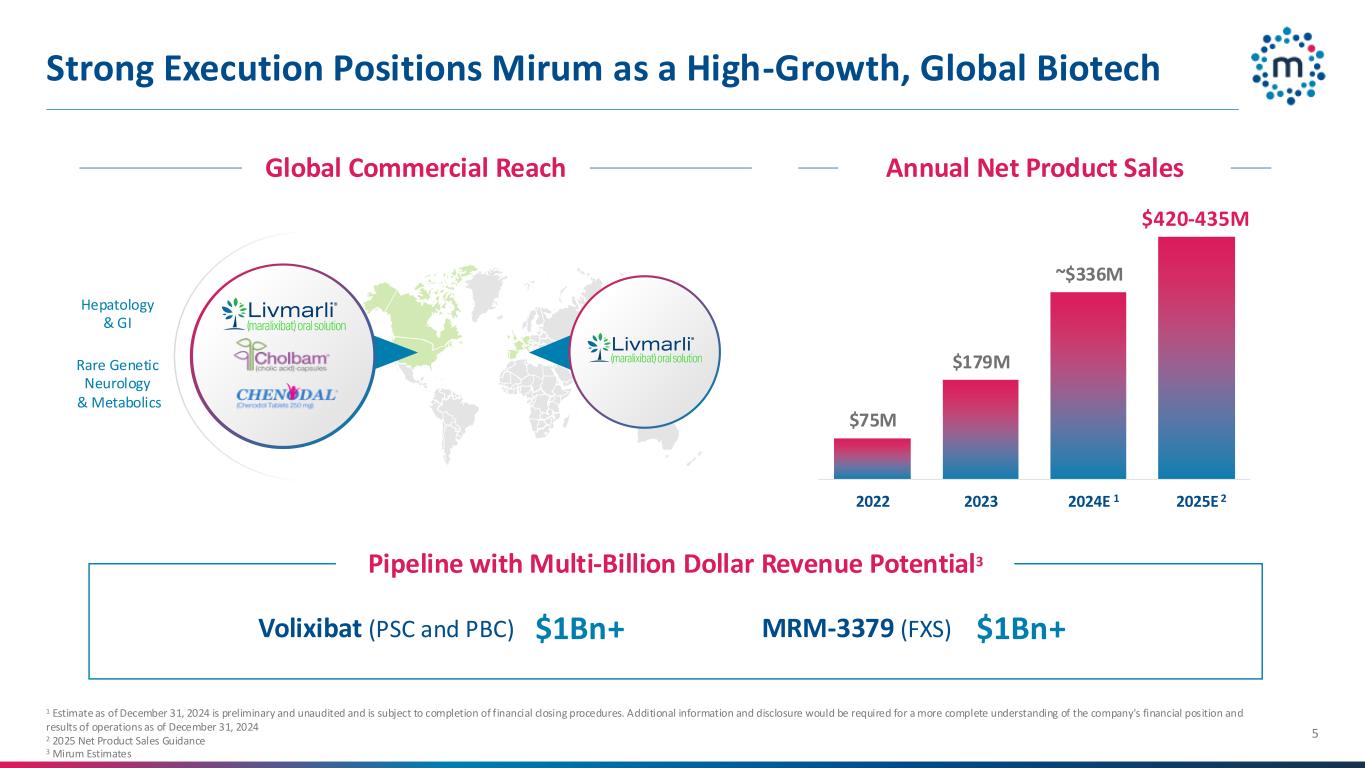
Strong Execution Positions Mirum as a High-Growth, Global Biotech 5 Hepatology & GI Rare Genetic Neurology & Metabolics 1 Estimate as of December 31, 2024 is preliminary and unaudited and is subject to completion of financial closing procedures. Additional information and disclosure would be required for a more complete understanding of the company's financial position and results of operations as of December 31, 2024 2 2025 Net Product Sales Guidance 3 Mirum Estimates Volixibat (PSC and PBC) $1Bn+ MRM-3379 (FXS) $1Bn+ $75M $179M ~$336M 2022 2023 2024E 2025E $420-435M 21 Annual Net Product SalesGlobal Commercial Reach Pipeline with Multi-Billion Dollar Revenue Potential3
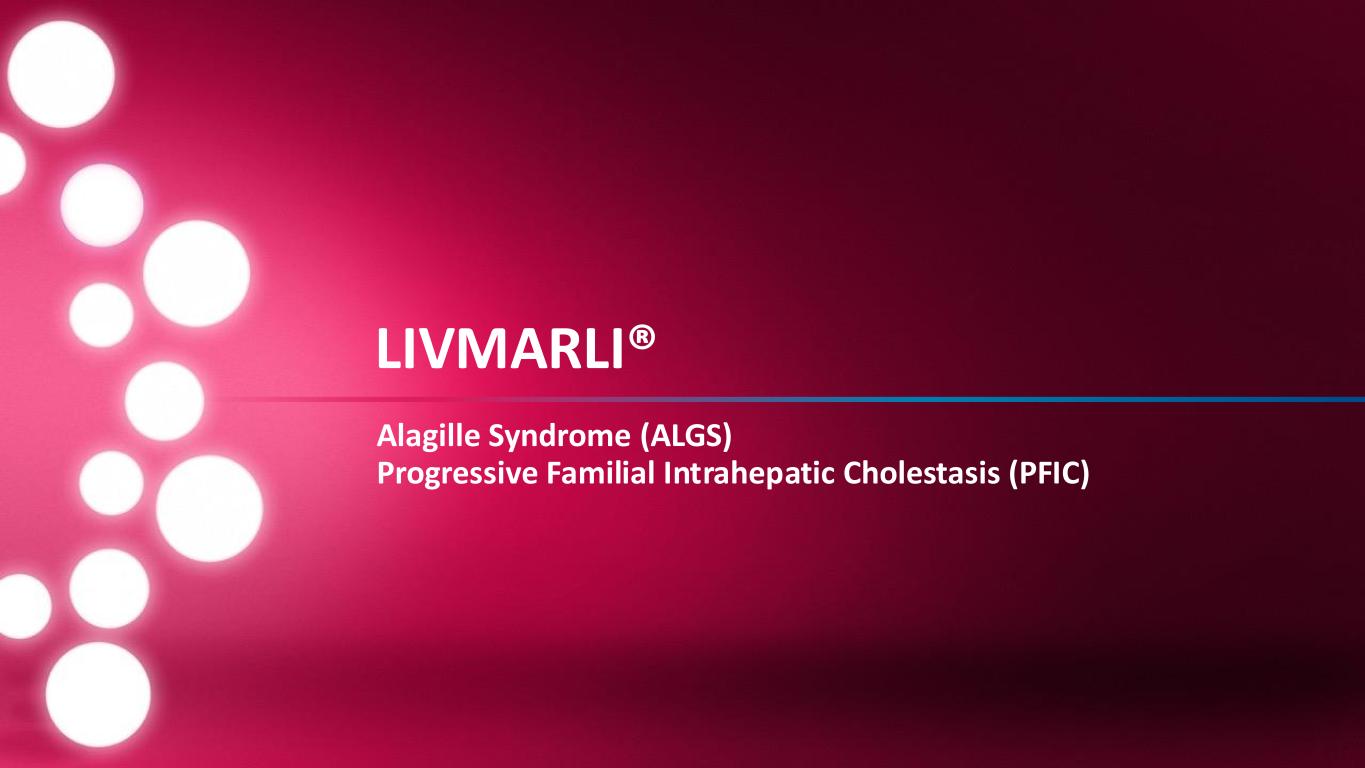
Alagille Syndrome (ALGS) Progressive Familial Intrahepatic Cholestasis (PFIC) LIVMARLI®
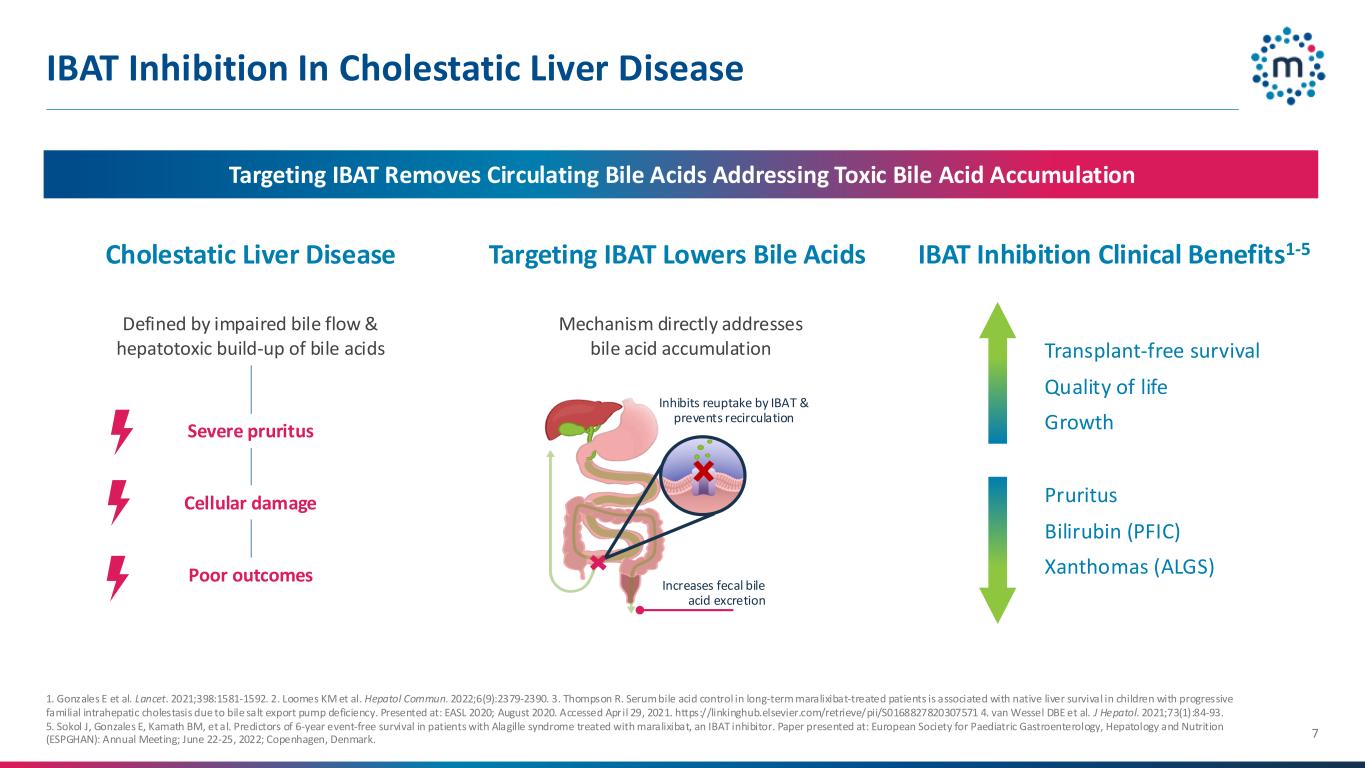
IBAT Inhibition In Cholestatic Liver Disease 7 Targeting IBAT Removes Circulating Bile Acids Addressing Toxic Bile Acid Accumulation Pruritus Bilirubin (PFIC) Xanthomas (ALGS) Transplant-free survival Quality of life Growth 1. Gonzales E et al. Lancet. 2021;398:1581-1592. 2. Loomes KM et al. Hepatol Commun. 2022;6(9):2379-2390. 3. Thompson R. Serum bile acid control in long-term maralixibat-treated patients is associated with native liver survival in children with progressive familial intrahepatic cholestasis due to bile salt export pump deficiency. Presented at: EASL 2020; August 2020. Accessed Apr il 29, 2021. https://linkinghub.elsevier.com/retrieve/pii/S0168827820307571 4. van Wessel DBE et al. J Hepatol. 2021;73(1):84-93. 5. Sokol J, Gonzales E, Kamath BM, et al. Predictors of 6-year event-free survival in patients with Alagille syndrome treated with maralixibat, an IBAT inhibitor. Paper presented at: European Society for Paediatric Gastroenterology, Hepatology and Nutrition (ESPGHAN): Annual Meeting; June 22-25, 2022; Copenhagen, Denmark. Inhibits reuptake by IBAT & prevents recirculation Increases fecal bile acid excretion Cholestatic Liver Disease Defined by impaired bile flow & hepatotoxic build-up of bile acids Targeting IBAT Lowers Bile Acids Mechanism directly addresses bile acid accumulation IBAT Inhibition Clinical Benefits1-5 Severe pruritus Cellular damage Poor outcomes

LIVMARLI: A Leading Medicine for Ultra Rare Cholestatic Pruritus 8 ALGS PFIC EXPAND Approved 4,000-5,500 US/EU prevalence ~200/yr annual incidence Approved 1,000+ US/EU prevalence ~70/yr annual incidence Phase 3 Pruritus in Rare Cholestatic Settings 1,000+ US/EU prevalence Sustained Long Term Growth ✓ Continued growth in new Rx ✓ Strong adherence & persistence ✓ Weight-based dosing ✓ Int’l market expansion ✓ IP Protection to 2040+
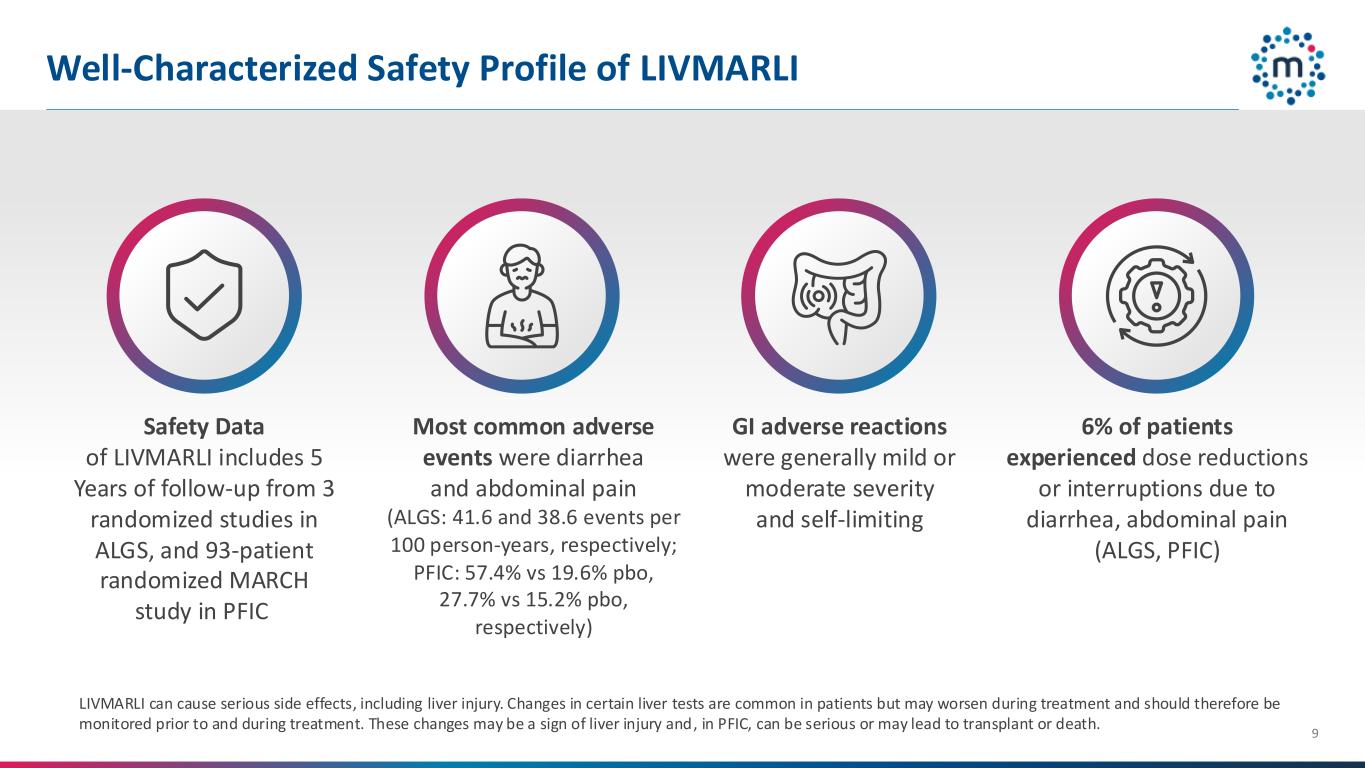
Well-Characterized Safety Profile of LIVMARLI 9 Safety Data of LIVMARLI includes 5 Years of follow-up from 3 randomized studies in ALGS, and 93-patient randomized MARCH study in PFIC Most common adverse events were diarrhea and abdominal pain (ALGS: 41.6 and 38.6 events per 100 person-years, respectively; PFIC: 57.4% vs 19.6% pbo, 27.7% vs 15.2% pbo, respectively) GI adverse reactions were generally mild or moderate severity and self-limiting 6% of patients experienced dose reductions or interruptions due to diarrhea, abdominal pain (ALGS, PFIC) LIVMARLI can cause serious side effects, including liver injury. Changes in certain liver tests are common in patients but may worsen during treatment and should therefore be monitored prior to and during treatment. These changes may be a sign of liver injury and, in PFIC, can be serious or may lead to transplant or death.
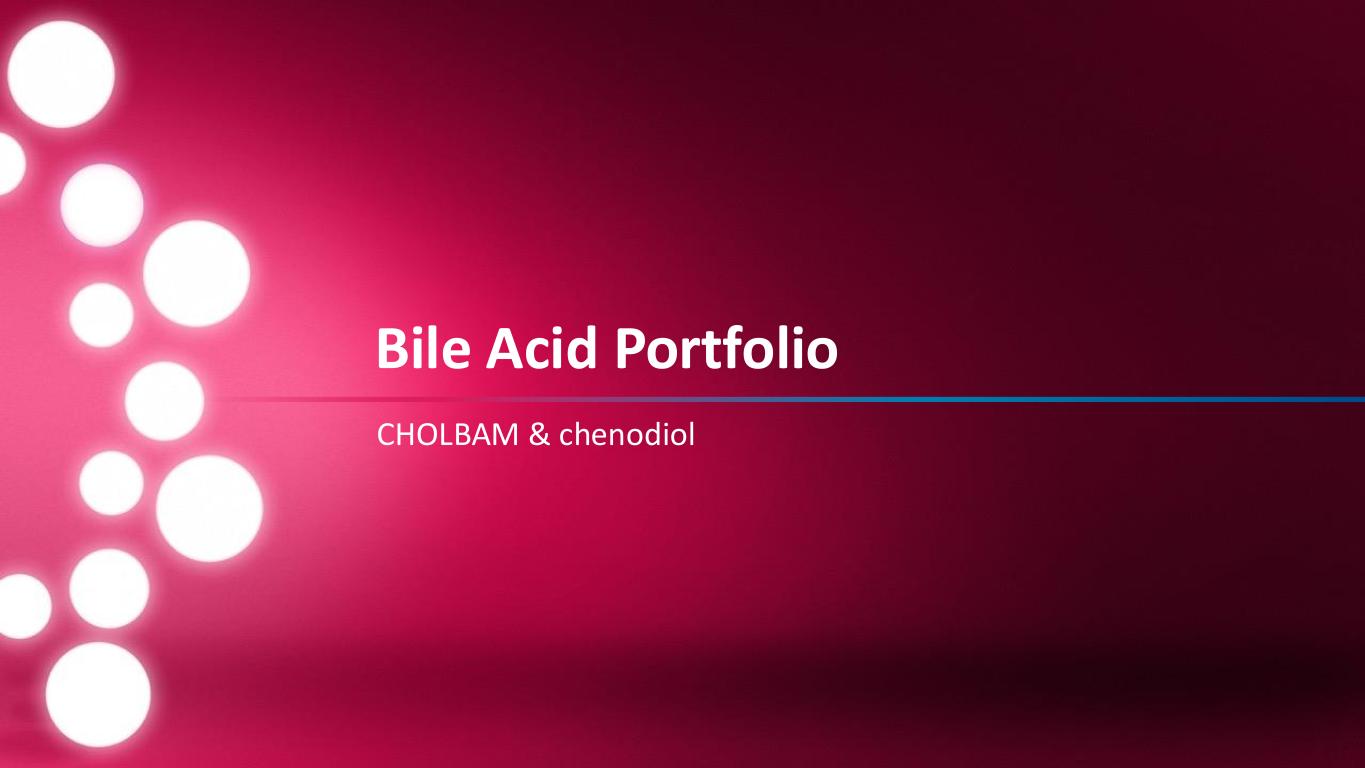
CHOLBAM & chenodiol Bile Acid Portfolio
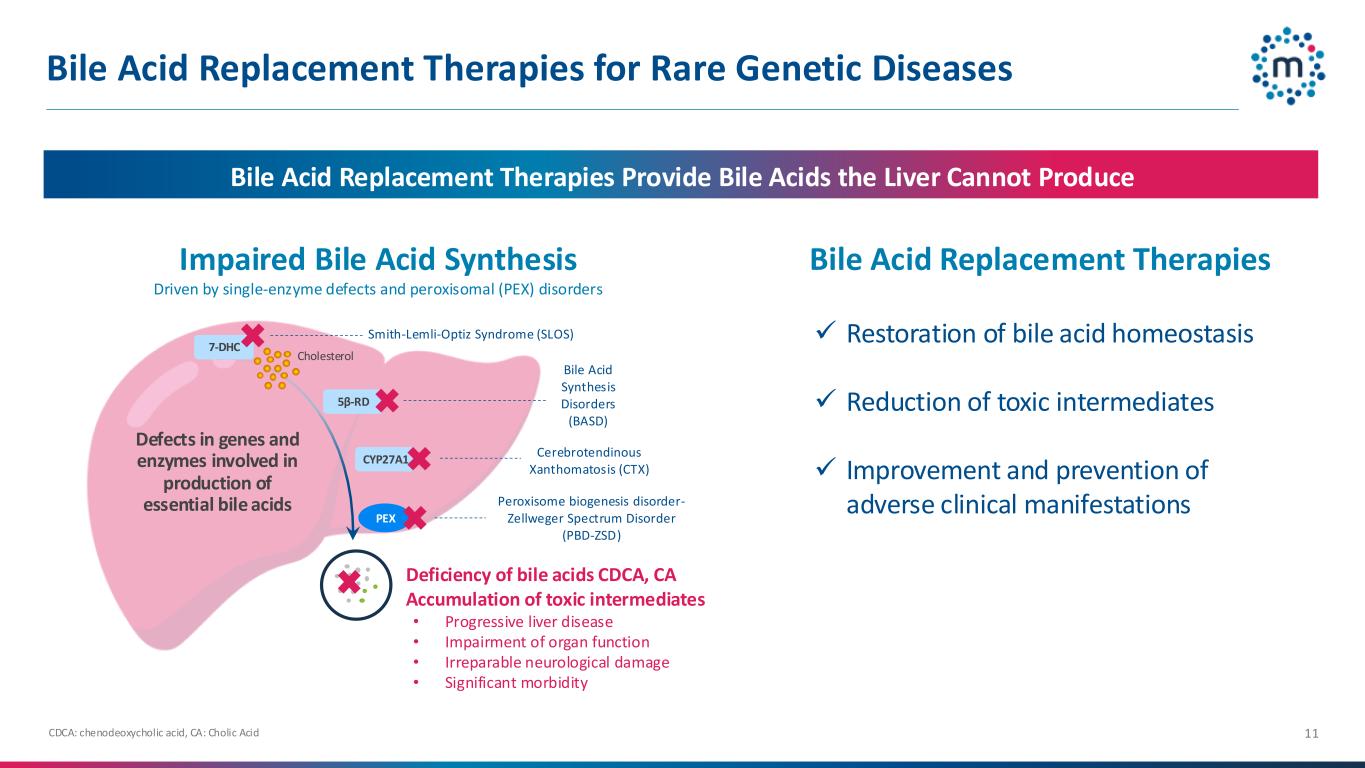
Bile Acid Replacement Therapies for Rare Genetic Diseases 11 Impaired Bile Acid Synthesis Driven by single-enzyme defects and peroxisomal (PEX) disorders Bile Acid Replacement Therapies Provide Bile Acids the Liver Cannot Produce Peroxisome biogenesis disorder- Zellweger Spectrum Disorder (PBD-ZSD) Smith-Lemli-Optiz Syndrome (SLOS) Deficiency of bile acids CDCA, CA Accumulation of toxic intermediates • Progressive liver disease • Impairment of organ function • Irreparable neurological damage • Significant morbidity 7-DHC 5β-RD CYP27A1 Cholesterol Defects in genes and enzymes involved in production of essential bile acids PEX Bile Acid Replacement Therapies ✓ Restoration of bile acid homeostasis ✓ Reduction of toxic intermediates ✓ Improvement and prevention of adverse clinical manifestations Bile Acid Synthesis Disorders (BASD) Cerebrotendinous Xanthomatosis (CTX) CDCA: chenodeoxycholic acid, CA: Cholic Acid
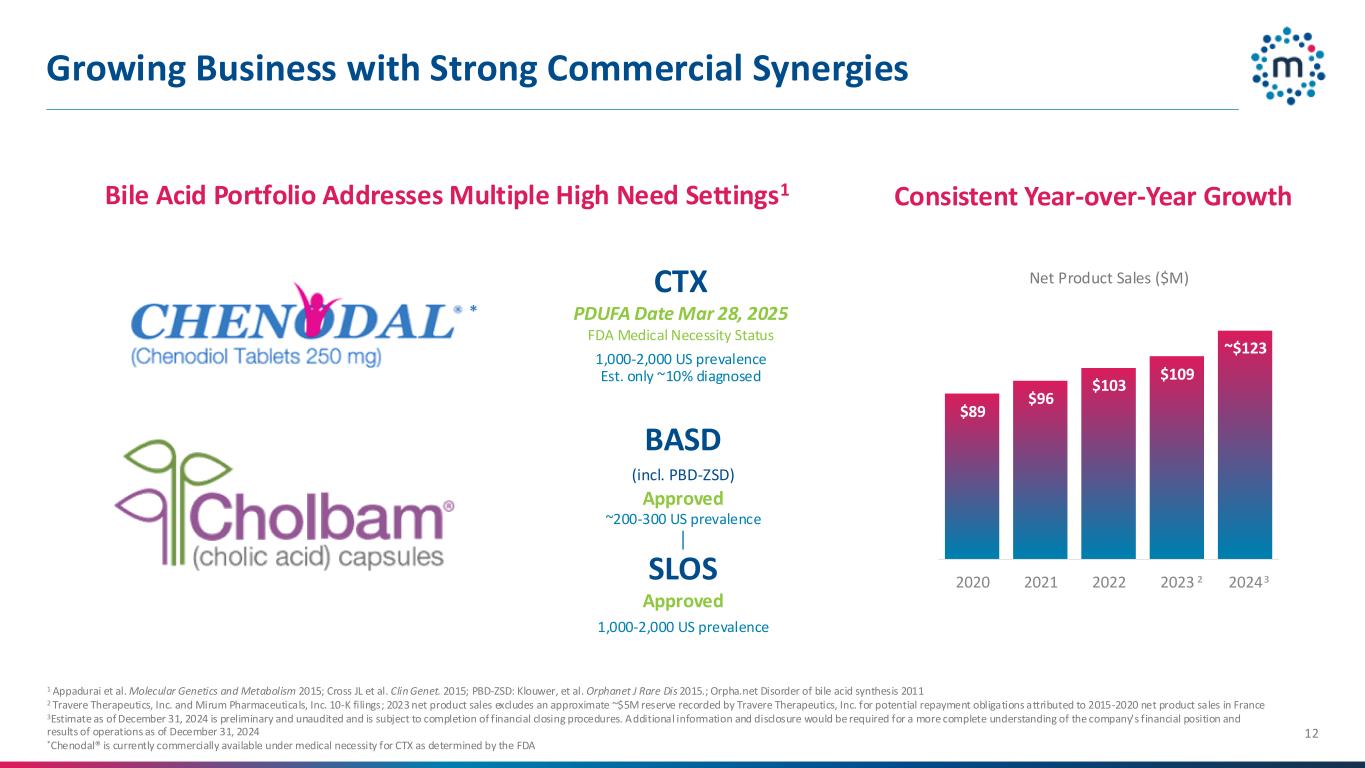
Growing Business with Strong Commercial Synergies 12 Bile Acid Portfolio Addresses Multiple High Need Settings1 1 Appadurai et al. Molecular Genetics and Metabolism 2015; Cross JL et al. Clin Genet. 2015; PBD-ZSD: Klouwer, et al. Orphanet J Rare Dis 2015.; Orpha.net Disorder of bile acid synthesis 2011 2 Travere Therapeutics, Inc. and Mirum Pharmaceuticals, Inc. 10-K filings; 2023 net product sales excludes an approximate ~$5M reserve recorded by Travere Therapeutics, Inc. for potential repayment obligations attributed to 2015-2020 net product sales in France 3Estimate as of December 31, 2024 is preliminary and unaudited and is subject to completion of financial closing procedures. Additional information and disclosure would be required for a more complete understanding of the company's financial position and results of operations as of December 31, 2024 *Chenodal® is currently commercially available under medical necessity for CTX as determined by the FDA $89 $96 $103 $109 ~$123 2020 2021 2022 2023 2024 Net Product Sales ($M) Consistent Year-over-Year Growth 1,000-2,000 US prevalence Est. only ~10% diagnosed ~200-300 US prevalence 1,000-2,000 US prevalence CTX PDUFA Date Mar 28, 2025 FDA Medical Necessity Status BASD (incl. PBD-ZSD) Approved SLOS Approved 2 3 *
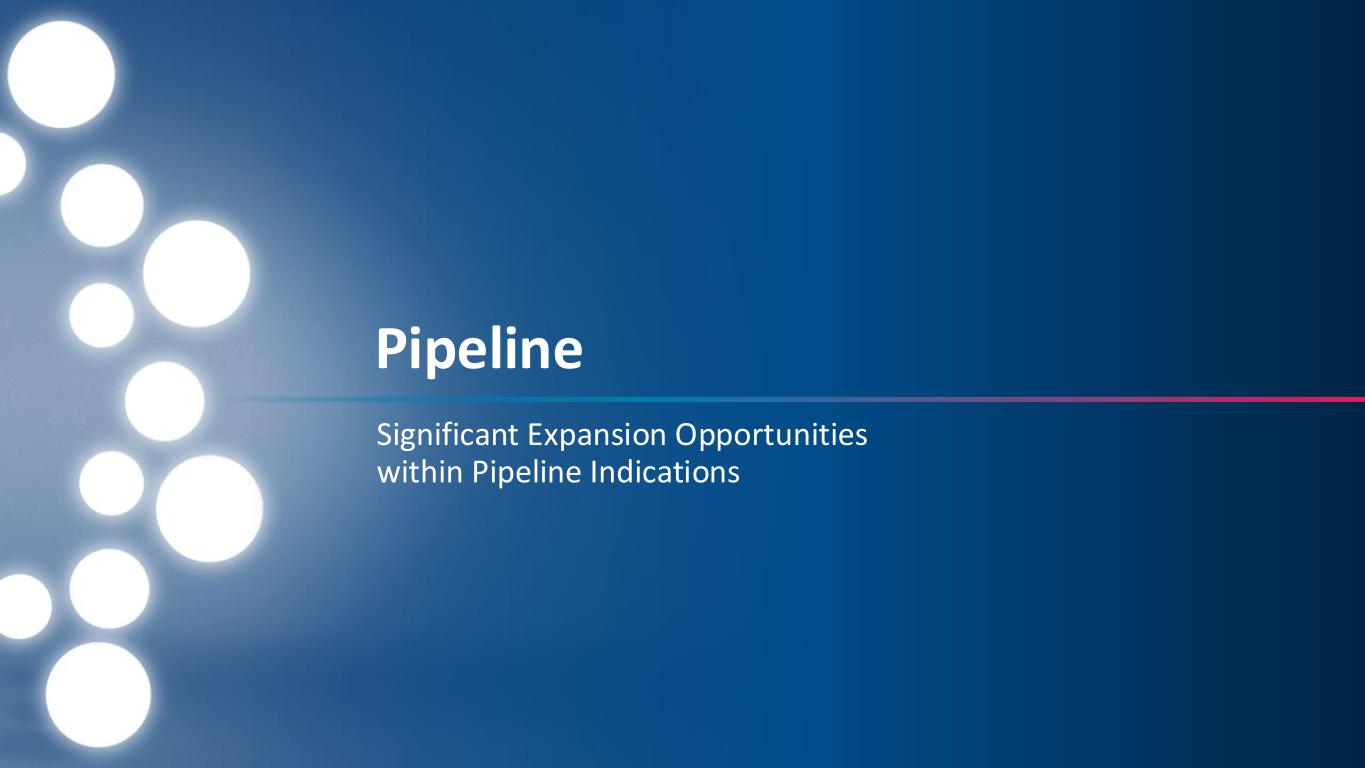
Significant Expansion Opportunities within Pipeline Indications Pipeline
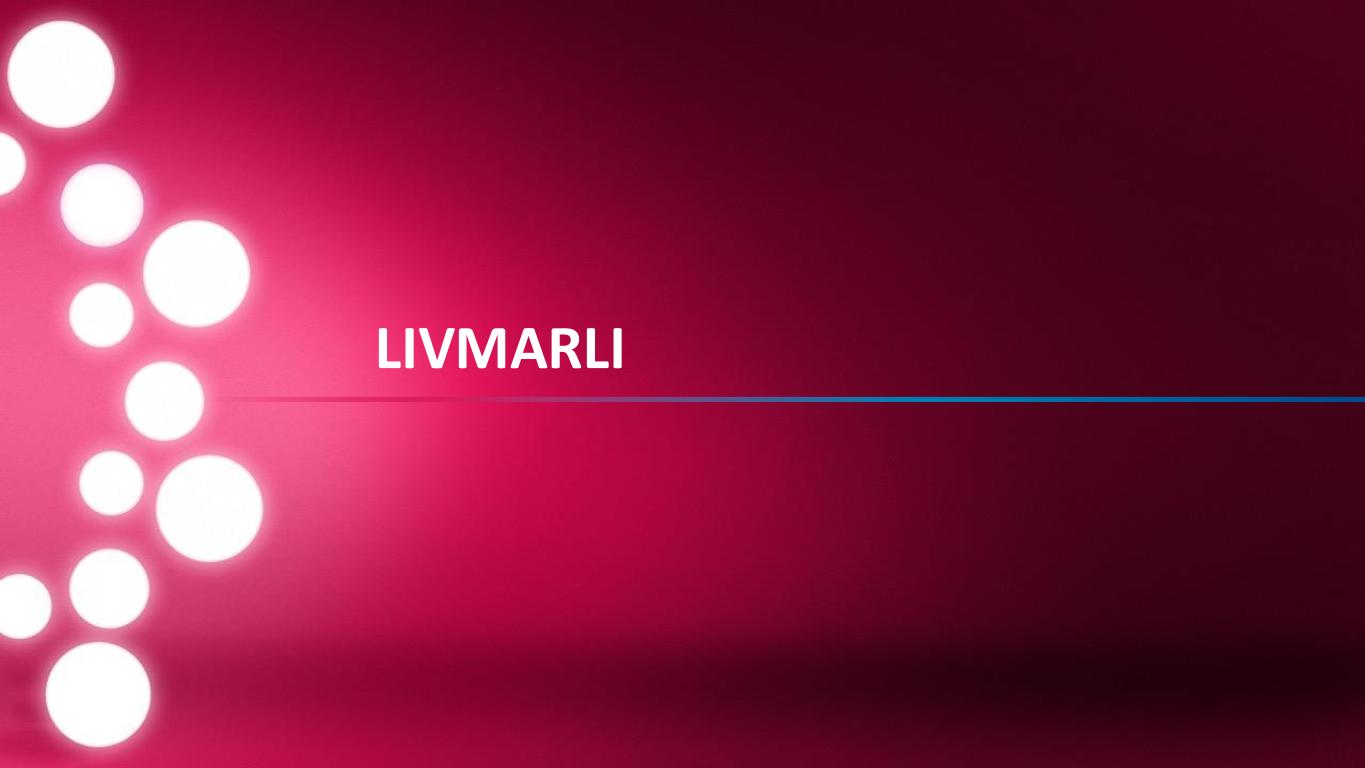
LIVMARLI
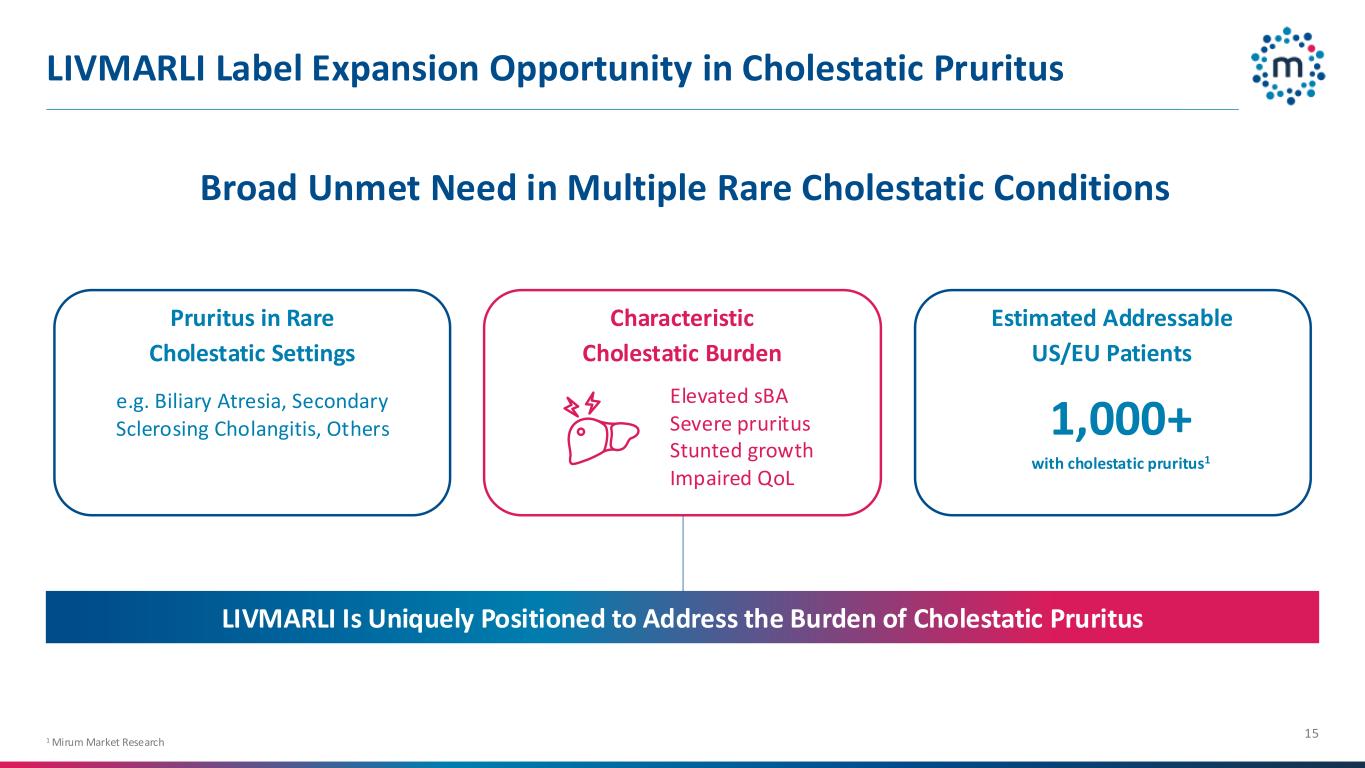
LIVMARLI Label Expansion Opportunity in Cholestatic Pruritus 15 Broad Unmet Need in Multiple Rare Cholestatic Conditions 1 Mirum Market Research Pruritus in Rare Cholestatic Settings Elevated sBA Severe pruritus Stunted growth Impaired QoL Characteristic Cholestatic Burden Estimated Addressable US/EU Patients 1,000+ with cholestatic pruritus1 LIVMARLI Is Uniquely Positioned to Address the Burden of Cholestatic Pruritus e.g. Biliary Atresia, Secondary Sclerosing Cholangitis, Others
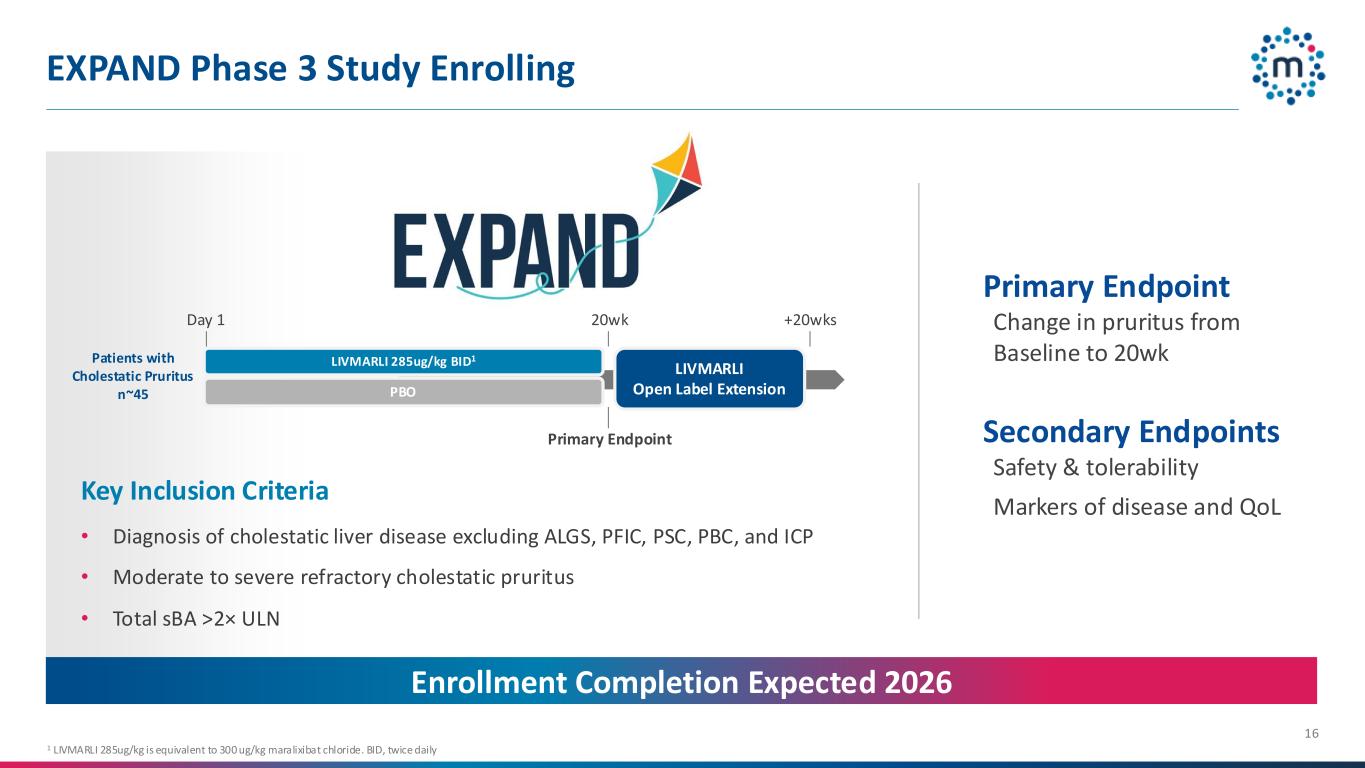
EXPAND Phase 3 Study Enrolling 16 Primary Endpoint Change in pruritus from Baseline to 20wk Secondary Endpoints Safety & tolerability Markers of disease and QoL +20wks Key Inclusion Criteria • Diagnosis of cholestatic liver disease excluding ALGS, PFIC, PSC, PBC, and ICP • Moderate to severe refractory cholestatic pruritus • Total sBA >2× ULN Primary Endpoint LIVMARLI 285ug/kg BID1 LIVMARLI Open Label Extension 20wkDay 1 1 LIVMARLI 285ug/kg is equivalent to 300 ug/kg maralixibat chloride. BID, twice daily PBO Patients with Cholestatic Pruritus n~45 Enrollment Completion Expected 2026
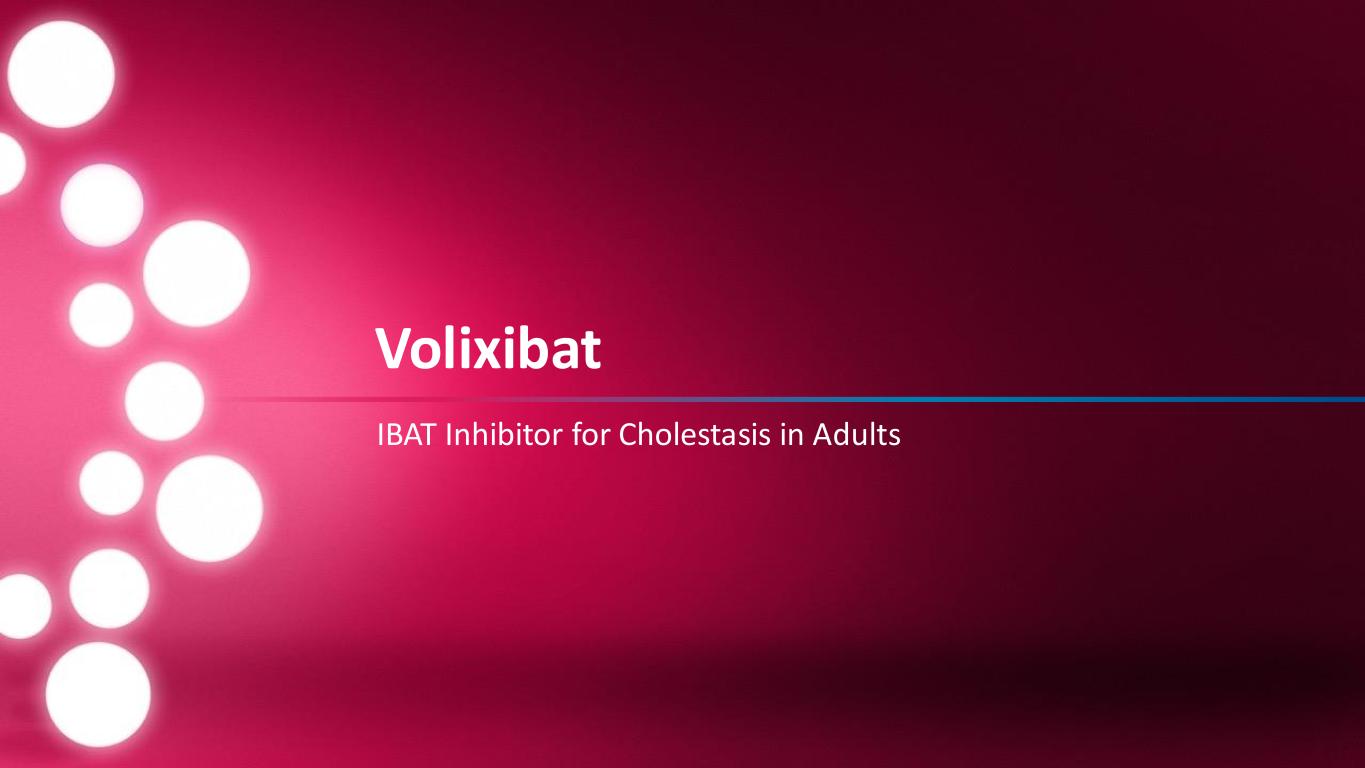
IBAT Inhibitor for Cholestasis in Adults Volixibat
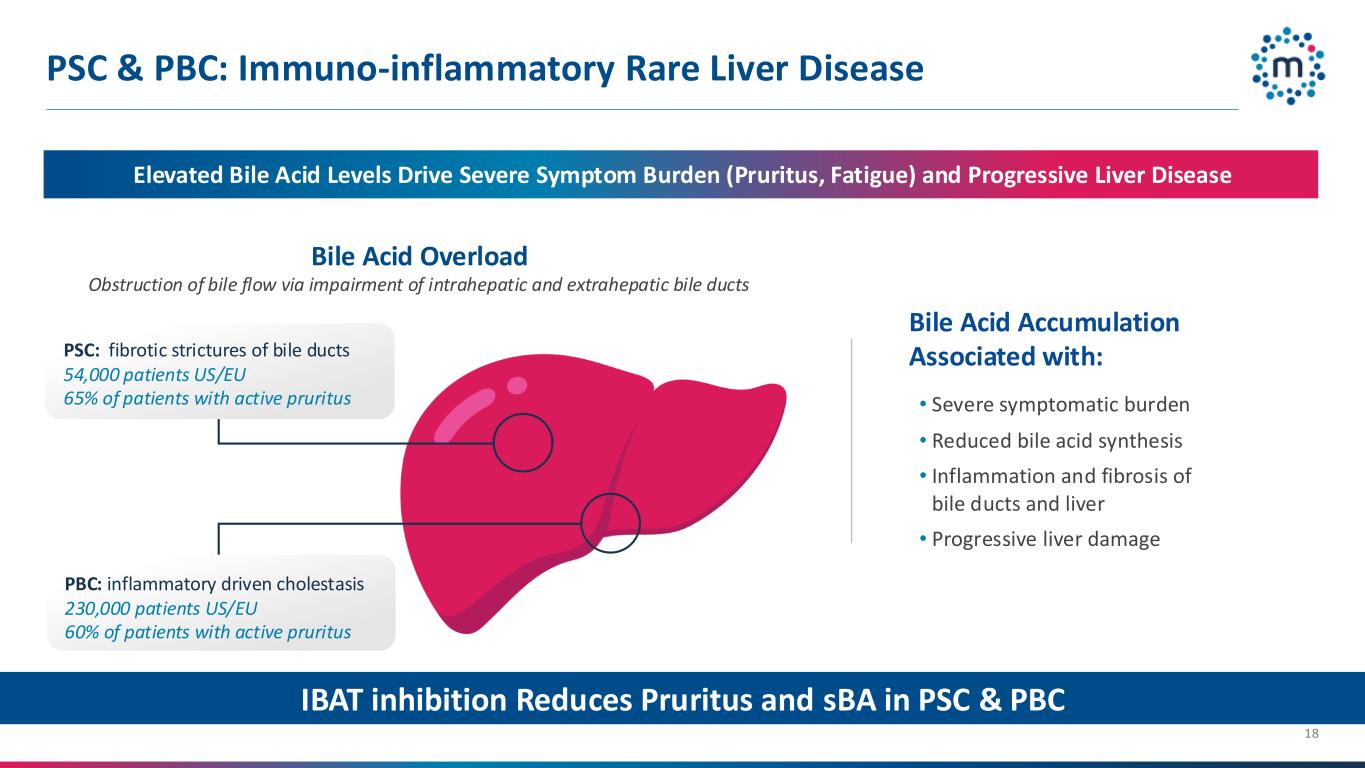
PSC & PBC: Immuno-inflammatory Rare Liver Disease Bile Acid Overload Obstruction of bile flow via impairment of intrahepatic and extrahepatic bile ducts Elevated Bile Acid Levels Drive Severe Symptom Burden (Pruritus, Fatigue) and Progressive Liver Disease Bile Acid Accumulation Associated with: • Severe symptomatic burden • Reduced bile acid synthesis • Inflammation and fibrosis of bile ducts and liver • Progressive liver damage PSC: fibrotic strictures of bile ducts 54,000 patients US/EU 65% of patients with active pruritus PBC: inflammatory driven cholestasis 230,000 patients US/EU 60% of patients with active pruritus IBAT inhibition Reduces Pruritus and sBA in PSC & PBC 18
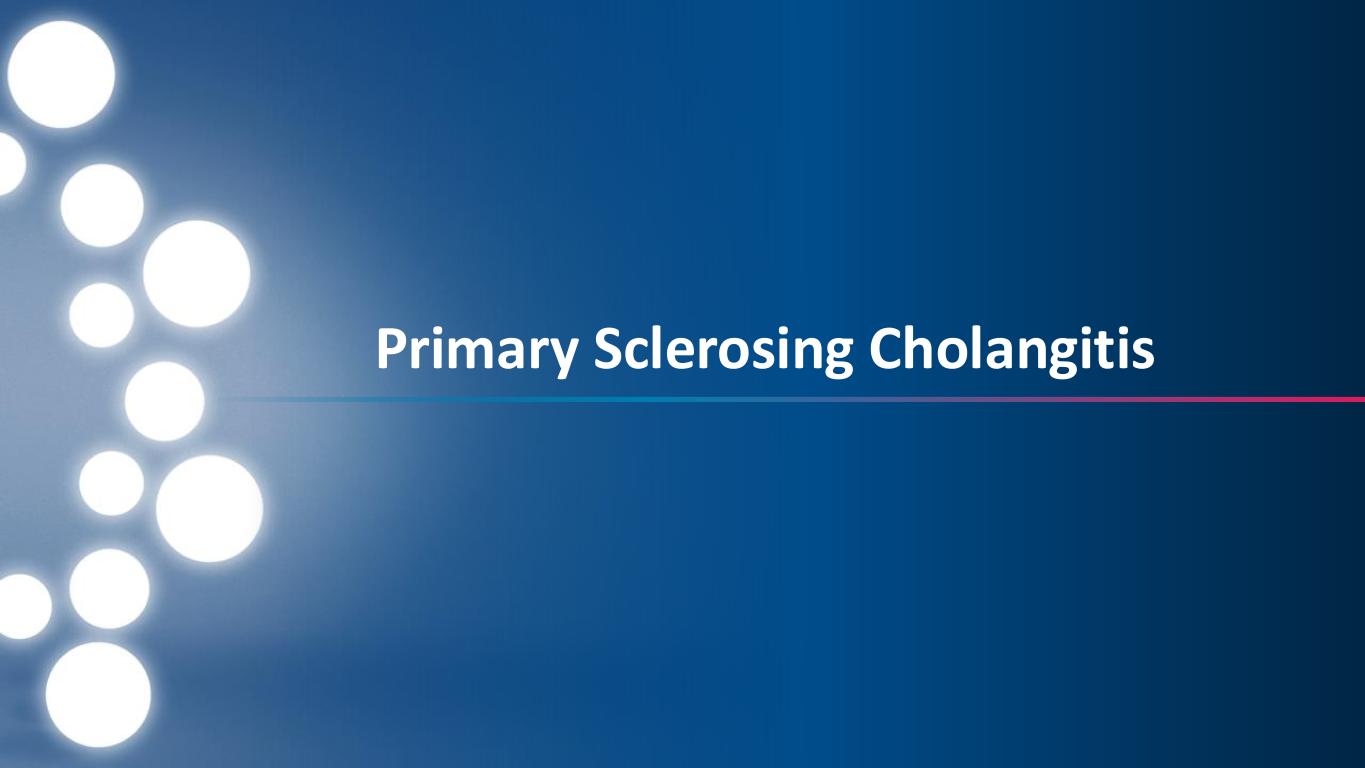
Primary Sclerosing Cholangitis
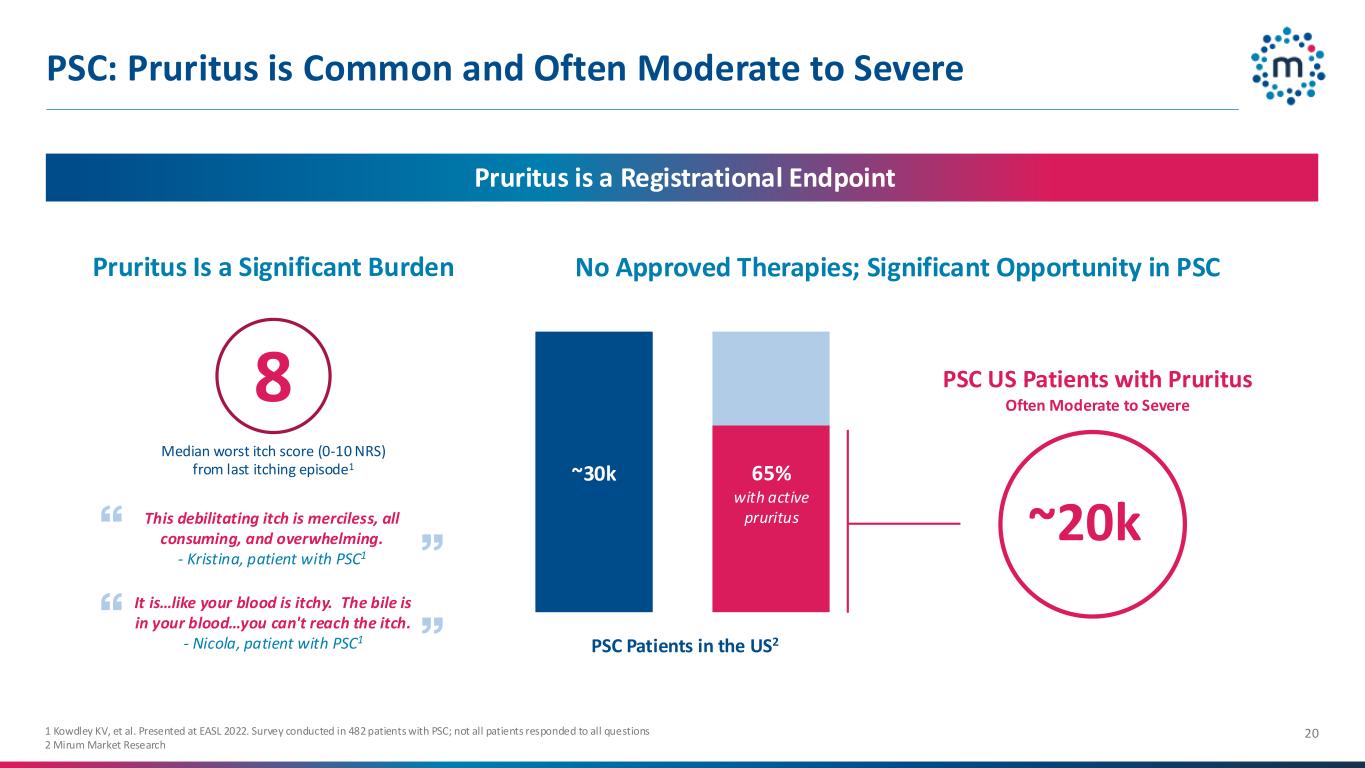
PSC: Pruritus is Common and Often Moderate to Severe 20 Pruritus Is a Significant Burden Median worst itch score (0-10 NRS) from last itching episode1 8 1 Kowdley KV, et al. Presented at EASL 2022. Survey conducted in 482 patients with PSC; not all patients responded to all questions 2 Mirum Market Research No Approved Therapies; Significant Opportunity in PSC ~30k PSC US Patients with Pruritus Often Moderate to Severe ~20k PSC Patients in the US2 65% with active pruritus Pruritus is a Registrational Endpoint It is…like your blood is itchy. The bile is in your blood…you can't reach the itch. - Nicola, patient with PSC1 This debilitating itch is merciless, all consuming, and overwhelming. - Kristina, patient with PSC1
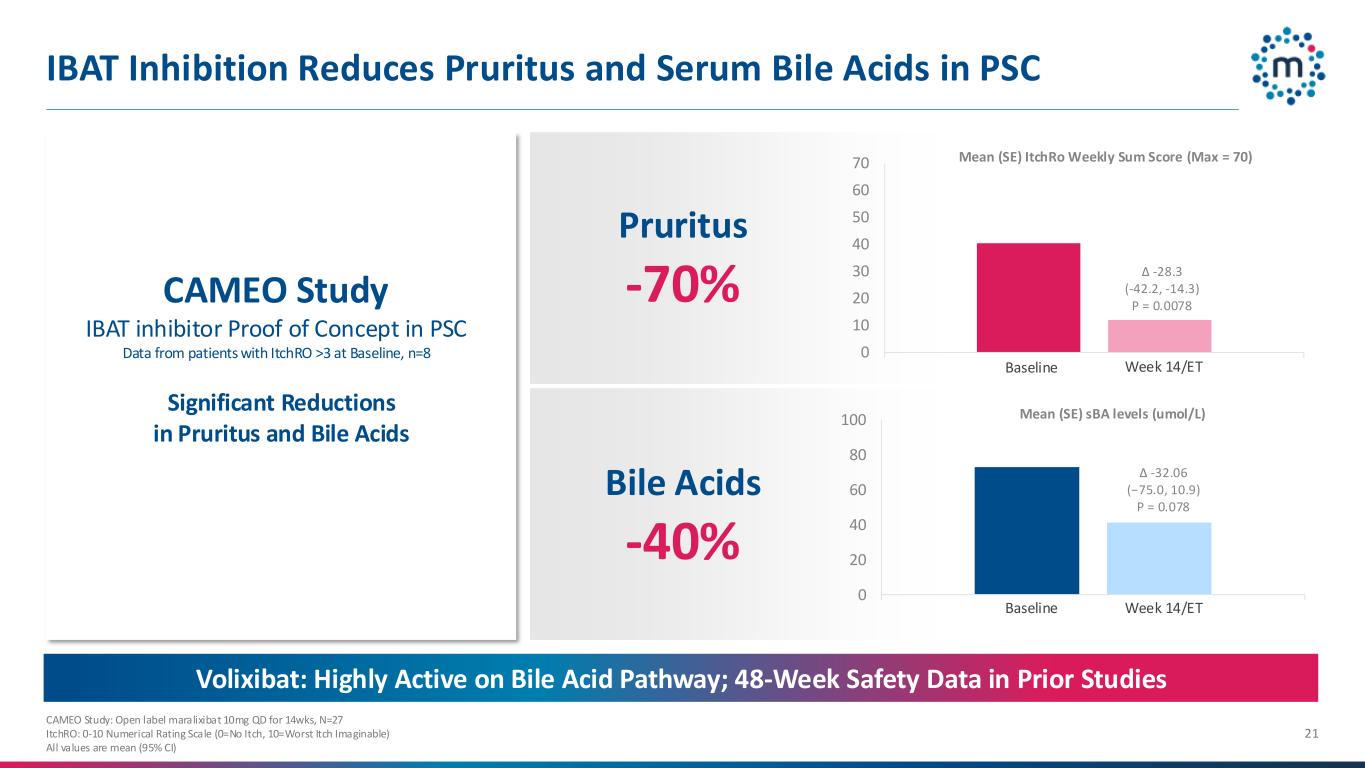
IBAT Inhibition Reduces Pruritus and Serum Bile Acids in PSC 21 CAMEO Study: Open label maralixibat 10mg QD for 14wks, N=27 ItchRO: 0-10 Numerical Rating Scale (0=No Itch, 10=Worst Itch Imaginable) All values are mean (95% CI) Volixibat: Highly Active on Bile Acid Pathway; 48-Week Safety Data in Prior Studies 0 10 20 30 40 50 60 70 CAMEO Study IBAT inhibitor Proof of Concept in PSC Data from patients with ItchRO >3 at Baseline, n=8 Baseline Week 14/ET Pruritus -70% Mean (SE) ItchRo Weekly Sum Score (Max = 70) 0 20 40 60 80 100 Bile Acids -40% Mean (SE) sBA levels (umol/L) Baseline Week 14/ET Δ -28.3 (-42.2, -14.3) P = 0.0078 Δ -32.06 (−75.0, 10.9) P = 0.078 Significant Reductions in Pruritus and Bile Acids
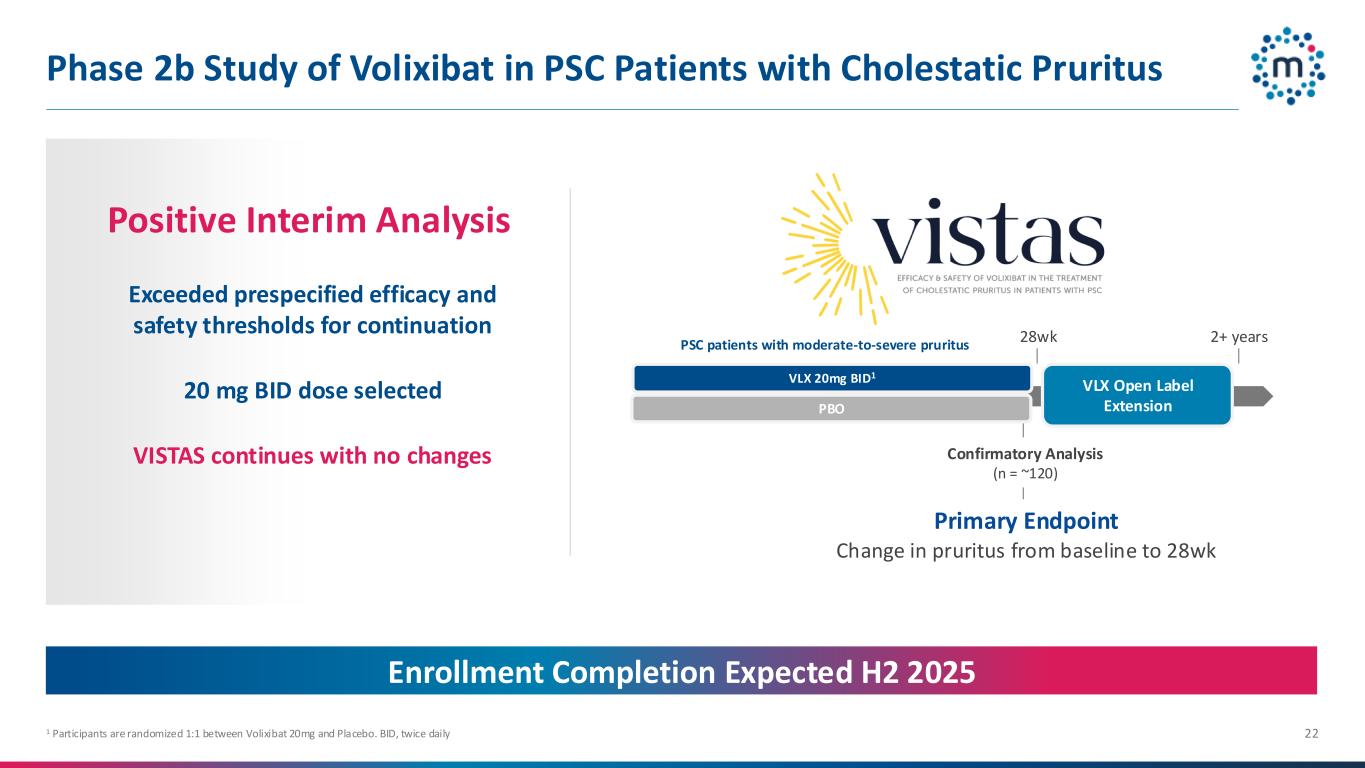
Phase 2b Study of Volixibat in PSC Patients with Cholestatic Pruritus 221 Participants are randomized 1:1 between Volixibat 20mg and Placebo. BID, twice daily 2+ years Confirmatory Analysis (n = ~120) VLX 20mg BID1 VLX Open Label Extension 28wk PBO PSC patients with moderate-to-severe pruritus Enrollment Completion Expected H2 2025 Primary Endpoint Change in pruritus from baseline to 28wk Exceeded prespecified efficacy and safety thresholds for continuation 20 mg BID dose selected VISTAS continues with no changes Positive Interim Analysis

Primary Biliary Cholangitis
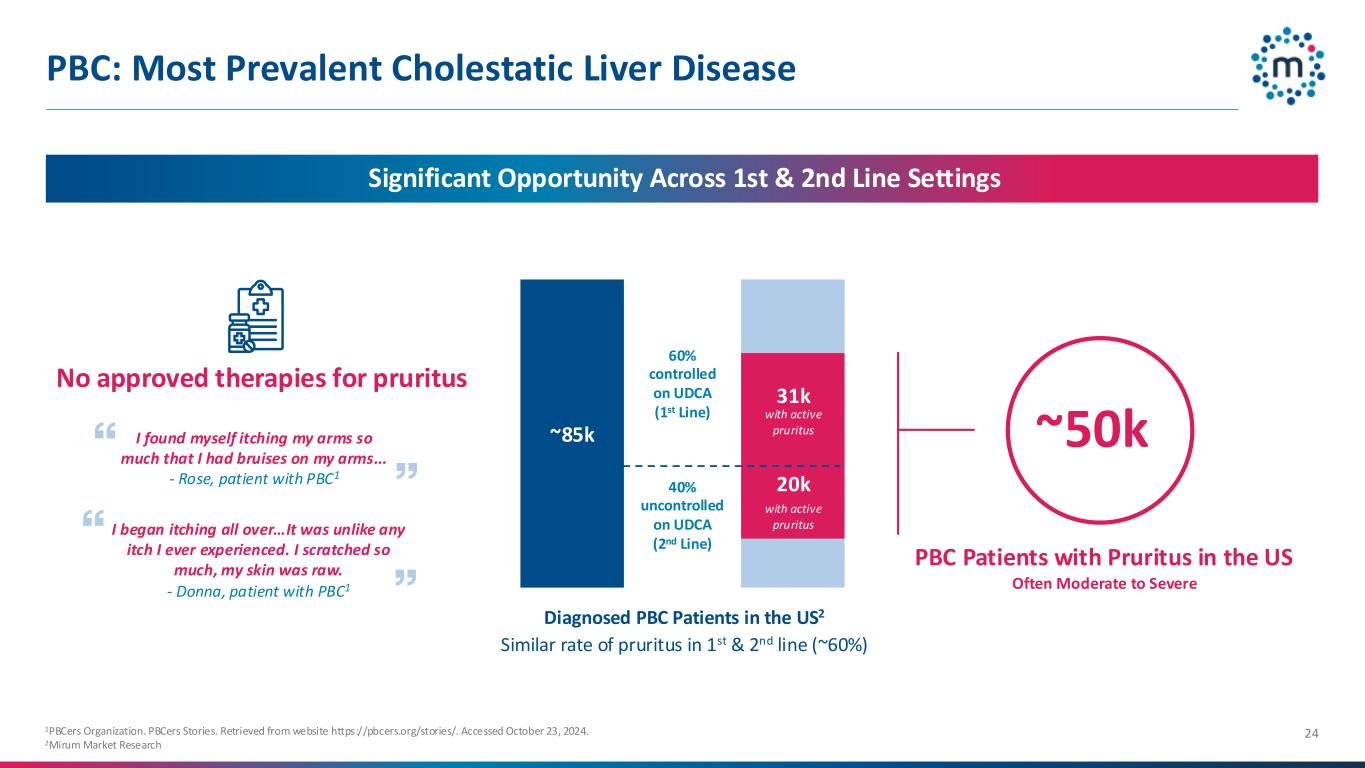
PBC: Most Prevalent Cholestatic Liver Disease 24 ~85k 20k 31k 60% controlled on UDCA (1st Line) 40% uncontrolled on UDCA (2nd Line) PBC Patients with Pruritus in the US Often Moderate to Severe No approved therapies for pruritus with active pruritus with active pruritus Diagnosed PBC Patients in the US2 Significant Opportunity Across 1st & 2nd Line Settings 1PBCers Organization. PBCers Stories. Retrieved from website https://pbcers.org/stories/. Accessed October 23, 2024. 2Mirum Market Research ~50kI found myself itching my arms so much that I had bruises on my arms... - Rose, patient with PBC1 I began itching all over…It was unlike any itch I ever experienced. I scratched so much, my skin was raw. - Donna, patient with PBC1 Similar rate of pruritus in 1st & 2nd line (~60%)
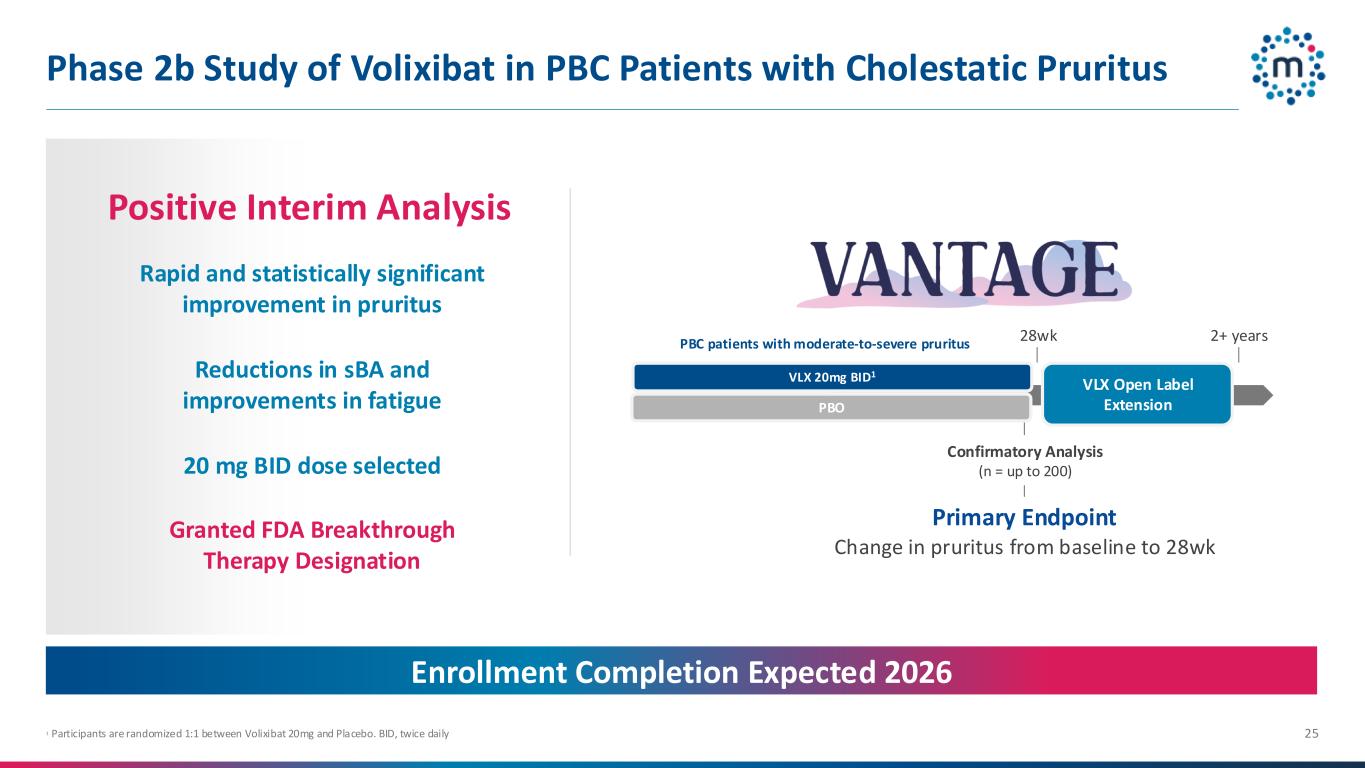
Phase 2b Study of Volixibat in PBC Patients with Cholestatic Pruritus 251 Participants are randomized 1:1 between Volixibat 20mg and Placebo. BID, twice daily 2+ years Confirmatory Analysis (n = up to 200) VLX 20mg BID1 VLX Open Label Extension 28wk PBO PBC patients with moderate-to-severe pruritus Enrollment Completion Expected 2026 Primary Endpoint Change in pruritus from baseline to 28wk Positive Interim Analysis Rapid and statistically significant improvement in pruritus Reductions in sBA and improvements in fatigue 20 mg BID dose selected Granted FDA Breakthrough Therapy Designation
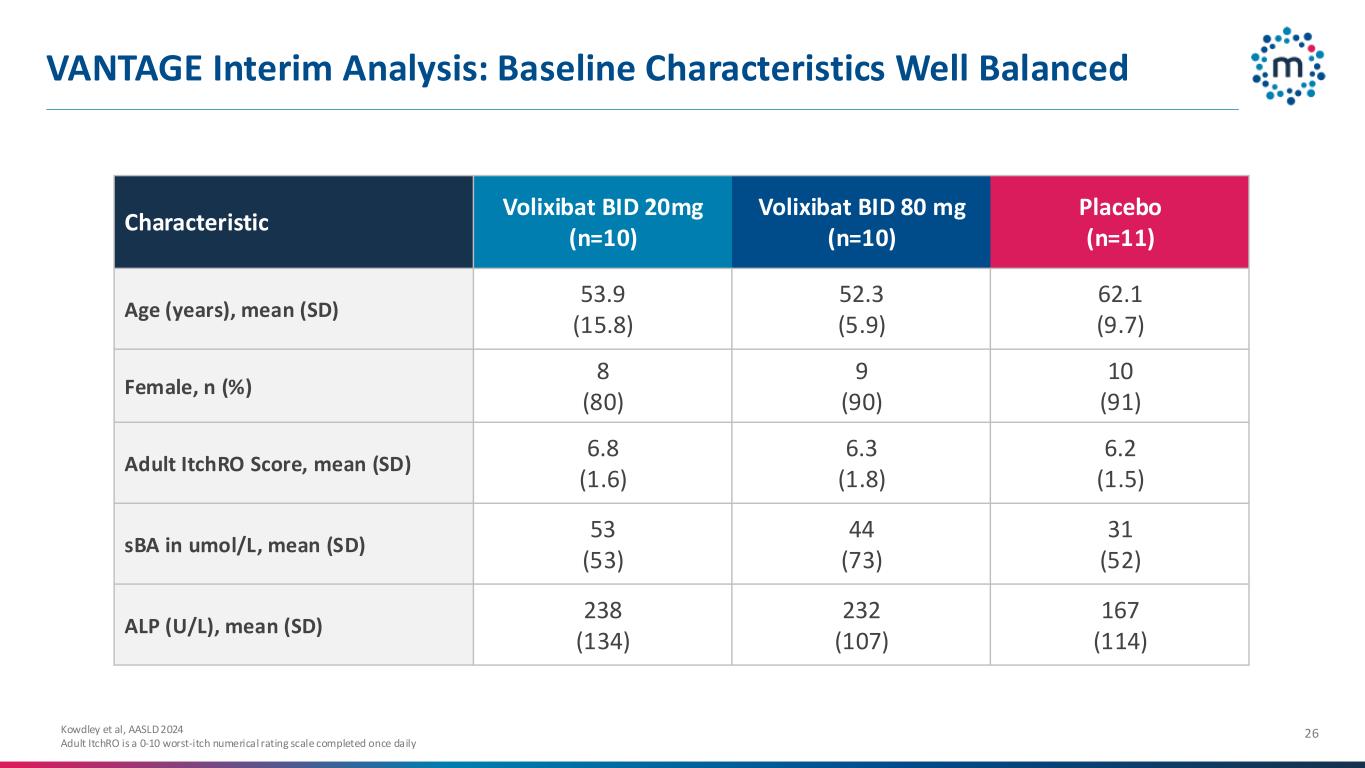
VANTAGE Interim Analysis: Baseline Characteristics Well Balanced 26 Characteristic Volixibat BID 20mg (n=10) Volixibat BID 80 mg (n=10) Placebo (n=11) Age (years), mean (SD) 53.9 (15.8) 52.3 (5.9) 62.1 (9.7) Female, n (%) 8 (80) 9 (90) 10 (91) Adult ItchRO Score, mean (SD) 6.8 (1.6) 6.3 (1.8) 6.2 (1.5) sBA in umol/L, mean (SD) 53 (53) 44 (73) 31 (52) ALP (U/L), mean (SD) 238 (134) 232 (107) 167 (114) Kowdley et al, AASLD 2024 Adult ItchRO is a 0-10 worst-itch numerical rating scale completed once daily
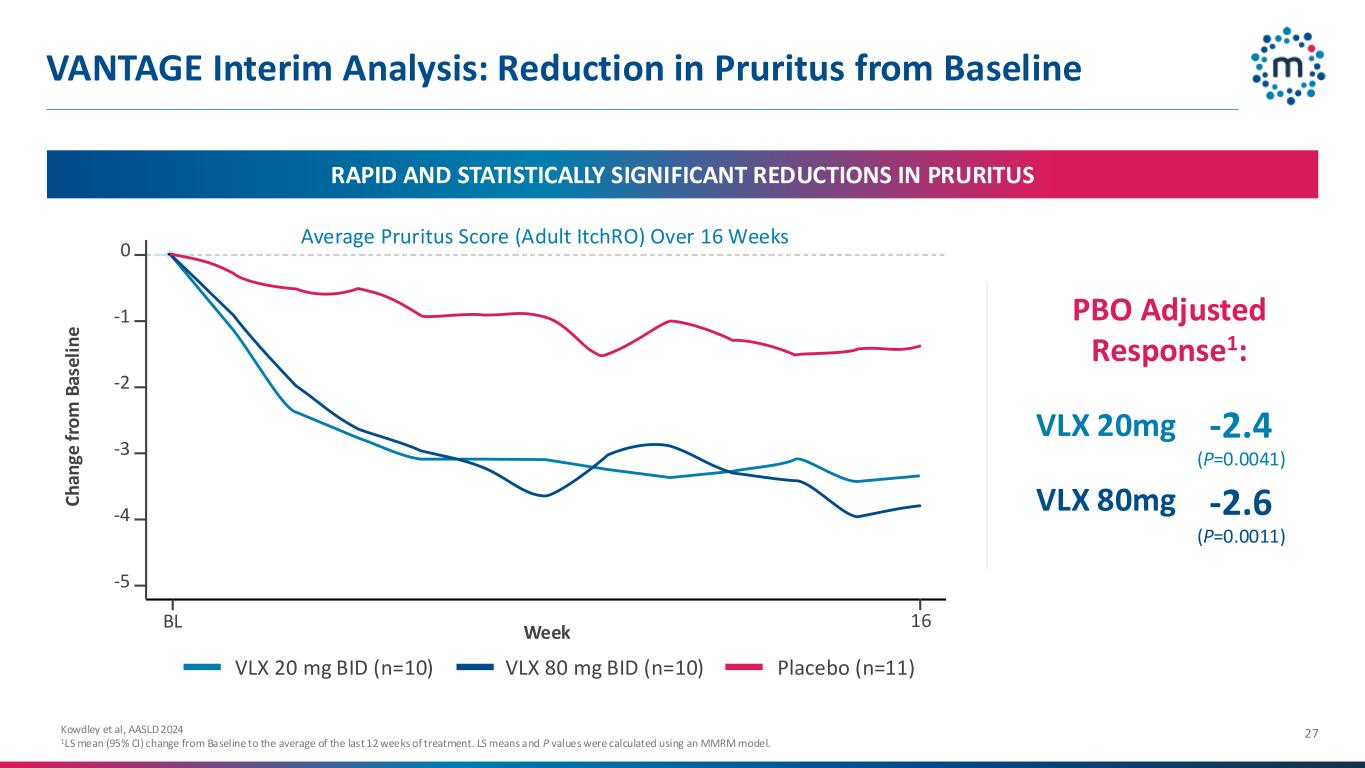
VANTAGE Interim Analysis: Reduction in Pruritus from Baseline 27Kowdley et al, AASLD 2024 1LS mean (95% CI) change from Baseline to the average of the last 12 weeks of treatment. LS means and P values were calculated using an MMRM model. Placebo (n=11)VLX 80 mg BID (n=10)VLX 20 mg BID (n=10) Week -5 -4 -3 -2 -1 0 C h an ge f ro m B as el in e BL 16 RAPID AND STATISTICALLY SIGNIFICANT REDUCTIONS IN PRURITUS -2.4 (P=0.0041) -2.6 (P=0.0011) PBO Adjusted Response1: VLX 20mg VLX 80mg Average Pruritus Score (Adult ItchRO) Over 16 Weeks
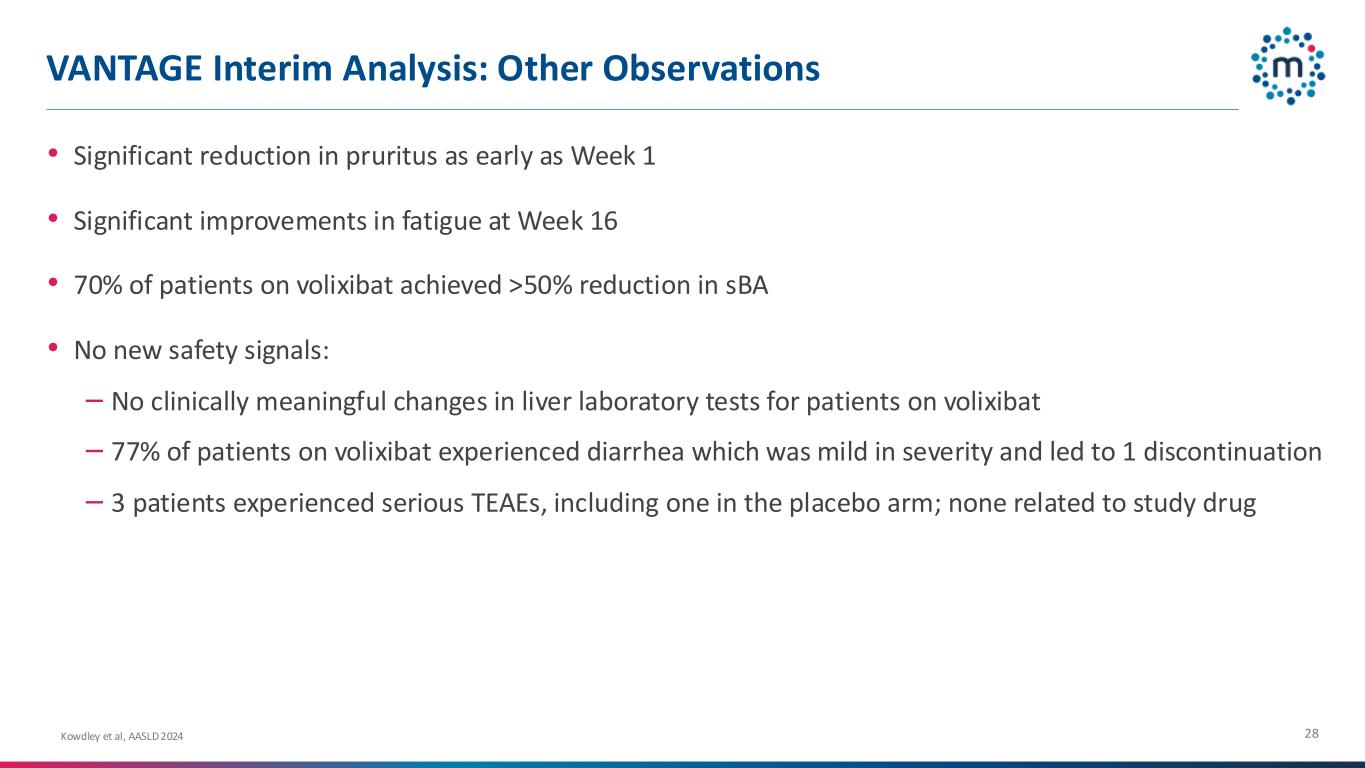
VANTAGE Interim Analysis: Other Observations 28 • Significant reduction in pruritus as early as Week 1 • Significant improvements in fatigue at Week 16 • 70% of patients on volixibat achieved >50% reduction in sBA • No new safety signals: – No clinically meaningful changes in liver laboratory tests for patients on volixibat – 77% of patients on volixibat experienced diarrhea which was mild in severity and led to 1 discontinuation – 3 patients experienced serious TEAEs, including one in the placebo arm; none related to study drug Kowdley et al, AASLD 2024

MRM-3379 PDE4D Inhibitor for FXS
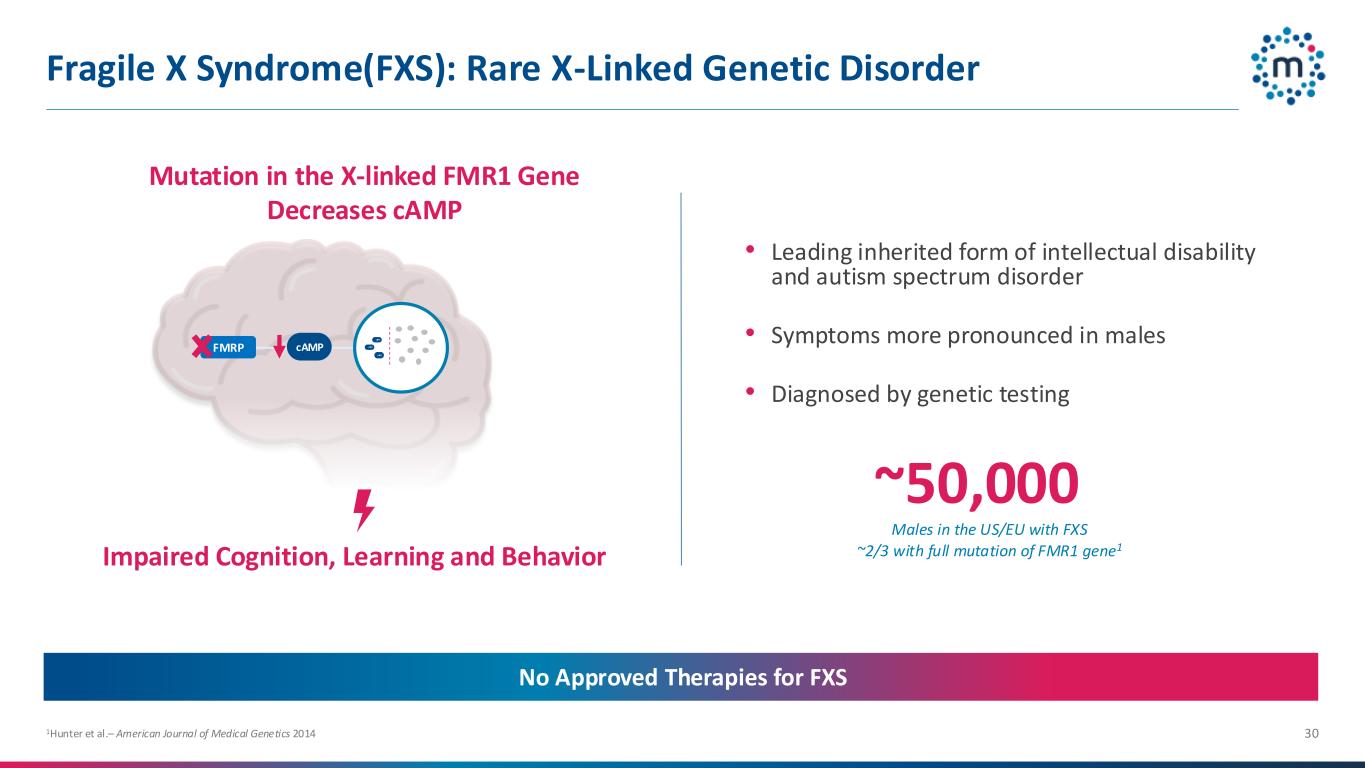
Fragile X Syndrome(FXS): Rare X-Linked Genetic Disorder 30 Mutation in the X-linked FMR1 Gene Decreases cAMP • Leading inherited form of intellectual disability and autism spectrum disorder • Symptoms more pronounced in males • Diagnosed by genetic testing No Approved Therapies for FXS FMRP cAMP cAM P cAM P cAM P Impaired Cognition, Learning and Behavior ~50,000 Males in the US/EU with FXS ~2/3 with full mutation of FMR1 gene1 1Hunter et al.– American Journal of Medical Genetics 2014
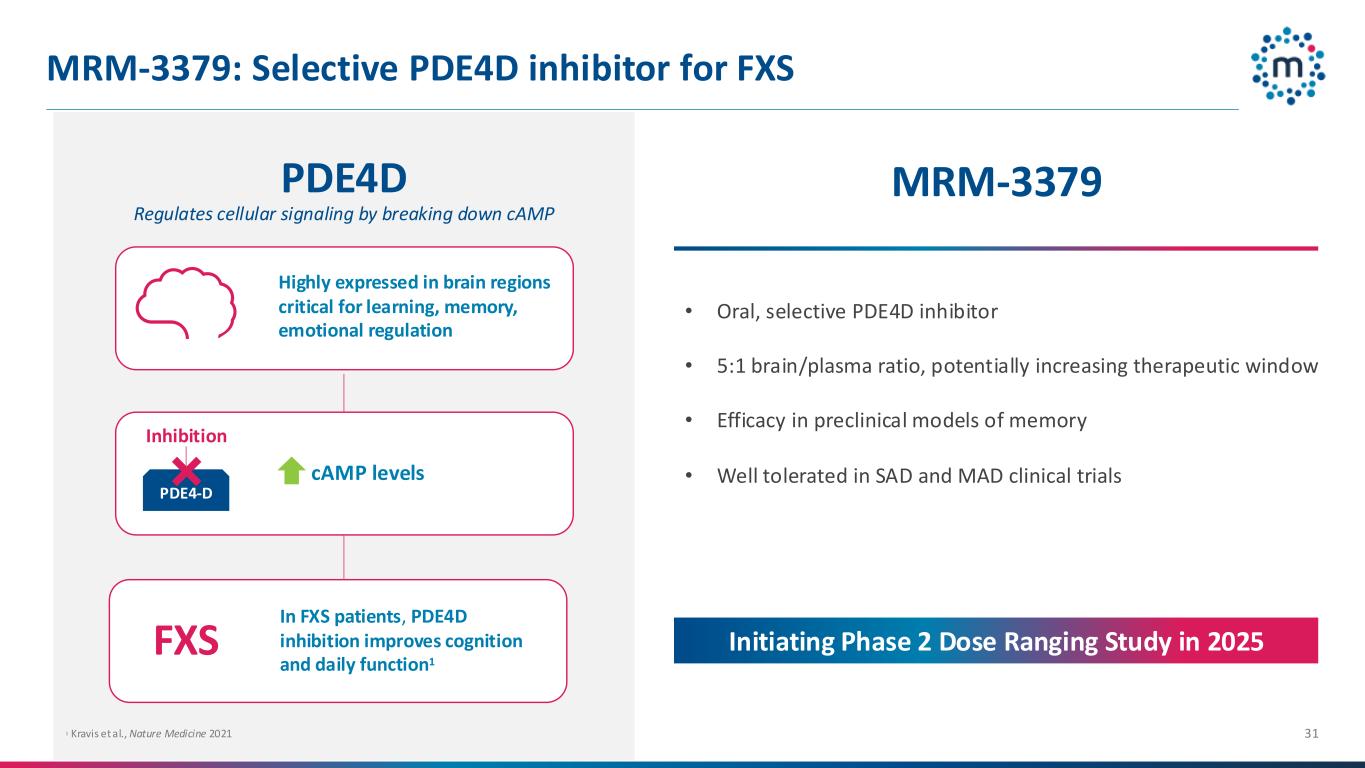
MRM-3379: Selective PDE4D inhibitor for FXS 31 In FXS patients, PDE4D inhibition improves cognition and daily function1 PDE4D Regulates cellular signaling by breaking down cAMP cAMP levels Highly expressed in brain regions critical for learning, memory, emotional regulation PDE4-D Inhibition FXS • Oral, selective PDE4D inhibitor • 5:1 brain/plasma ratio, potentially increasing therapeutic window • Efficacy in preclinical models of memory • Well tolerated in SAD and MAD clinical trials MRM-3379 Initiating Phase 2 Dose Ranging Study in 2025 1 Kravis et al., Nature Medicine 2021

Dedicated to Transforming the Treatment of Rare Diseases Mirum Pharmaceuticals
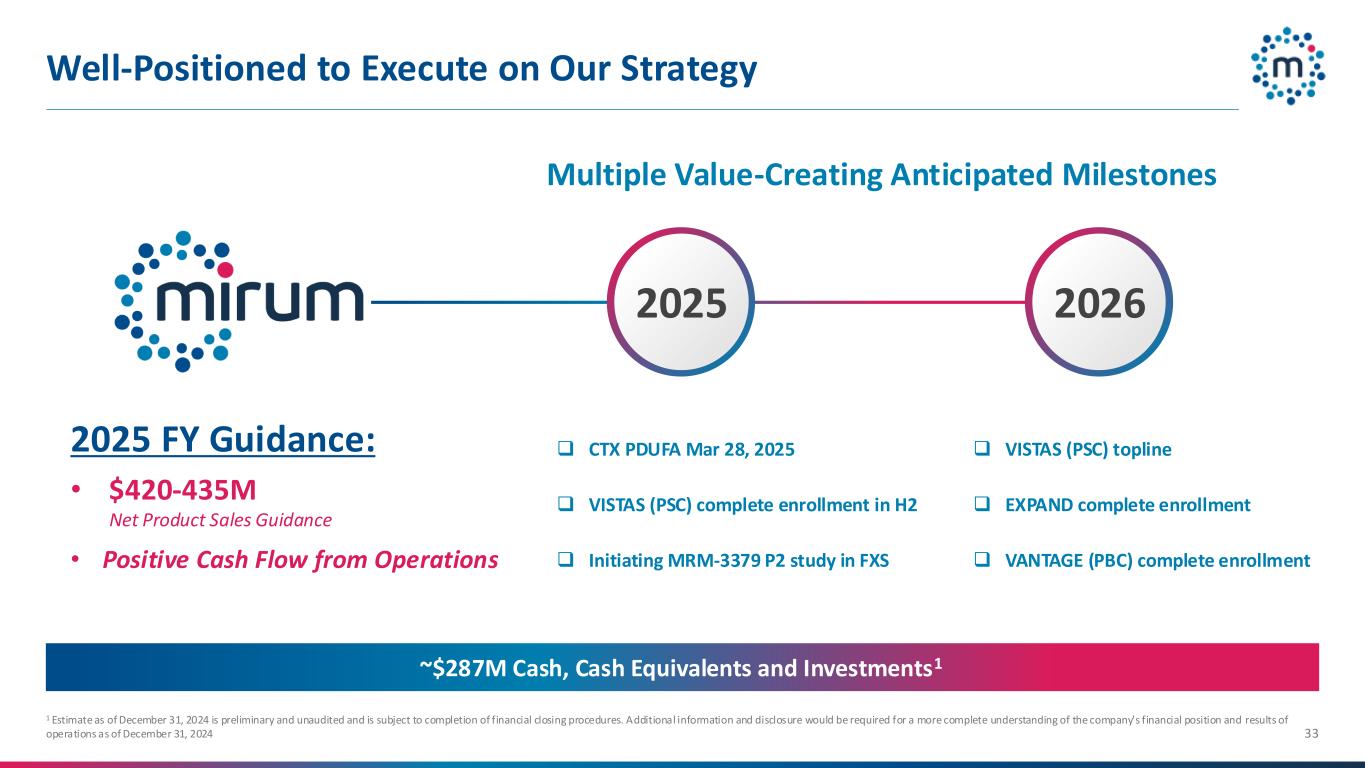
Well-Positioned to Execute on Our Strategy 33 1 Estimate as of December 31, 2024 is preliminary and unaudited and is subject to completion of financial closing procedures. Additional information and disclosure would be required for a more complete understanding of the company's financial position and results of operations as of December 31, 2024 ❑ CTX PDUFA Mar 28, 2025 ❑ VISTAS (PSC) complete enrollment in H2 ❑ Initiating MRM-3379 P2 study in FXS ❑ VANTAGE (PBC) complete enrollment ❑ EXPAND complete enrollment ❑ VISTAS (PSC) topline 2025 2026 2025 FY Guidance: • $420-435M Net Product Sales Guidance • Positive Cash Flow from Operations ~$287M Cash, Cash Equivalents and Investments1 Multiple Value-Creating Anticipated Milestones
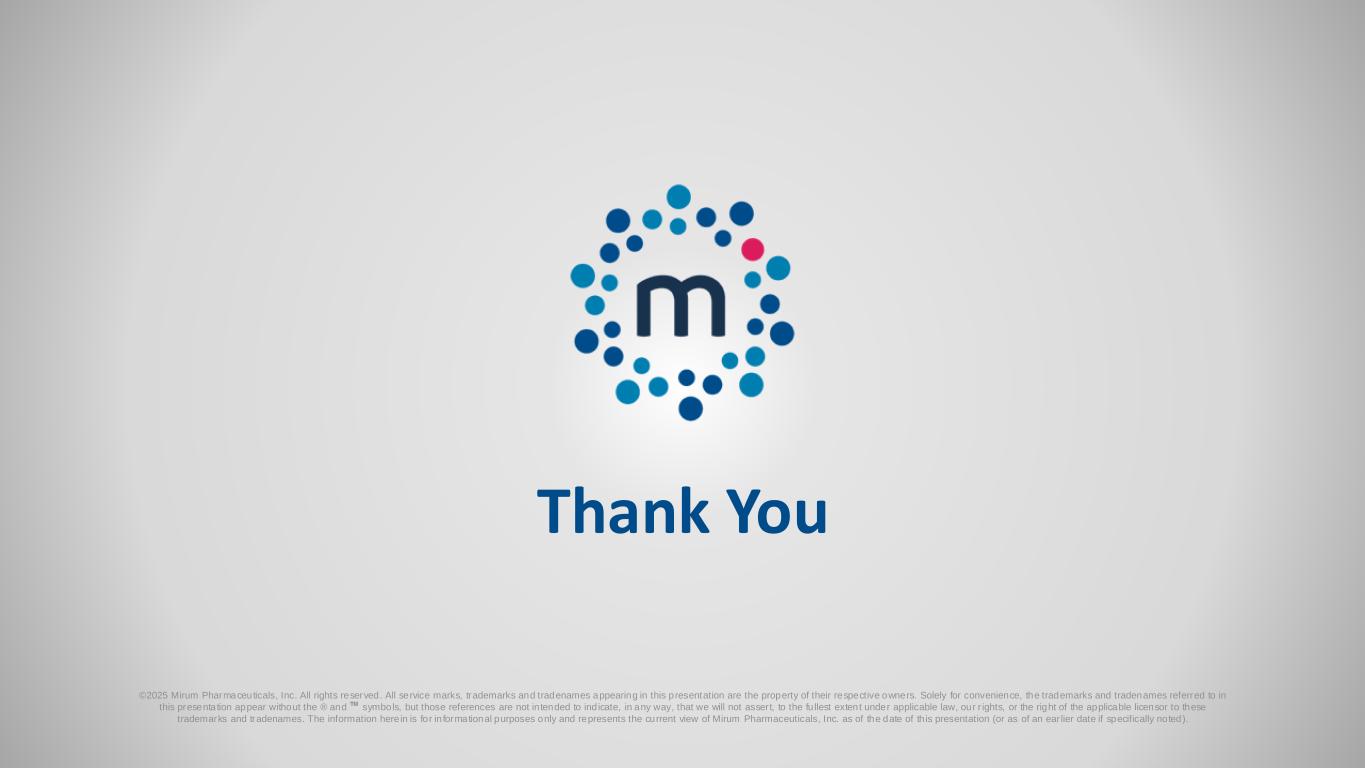
©2025 Mirum Pharmaceuticals, Inc. All rights reserved. All service marks, trademarks and tradenames appearing in this presentation are the property of their respective owners. Solely for convenience, the trademarks and tradenames referred to in this presentation appear without the ® and symbols, but those references are not in tended to ind icate, in any way, that we will not asser t, to the fu llest extent under applicable law, our r ights, or the right of the applicable licensor to these trademarks and tradenames. The information here in is for in formational purposes only and represents the current view of Mirum Pharmaceuticals, Inc. as of the date of th is presentation (or as of an ear lier date if specifically noted). Thank You
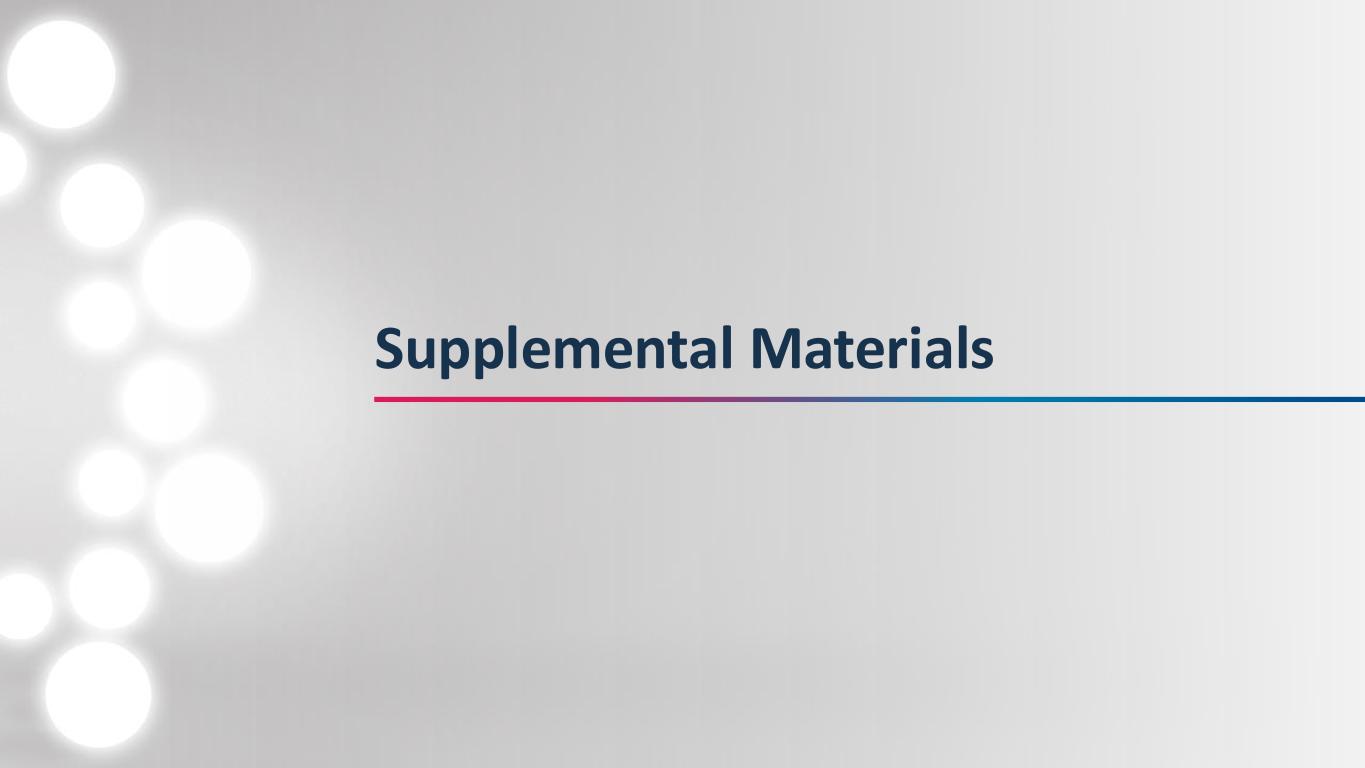
Supplemental Materials
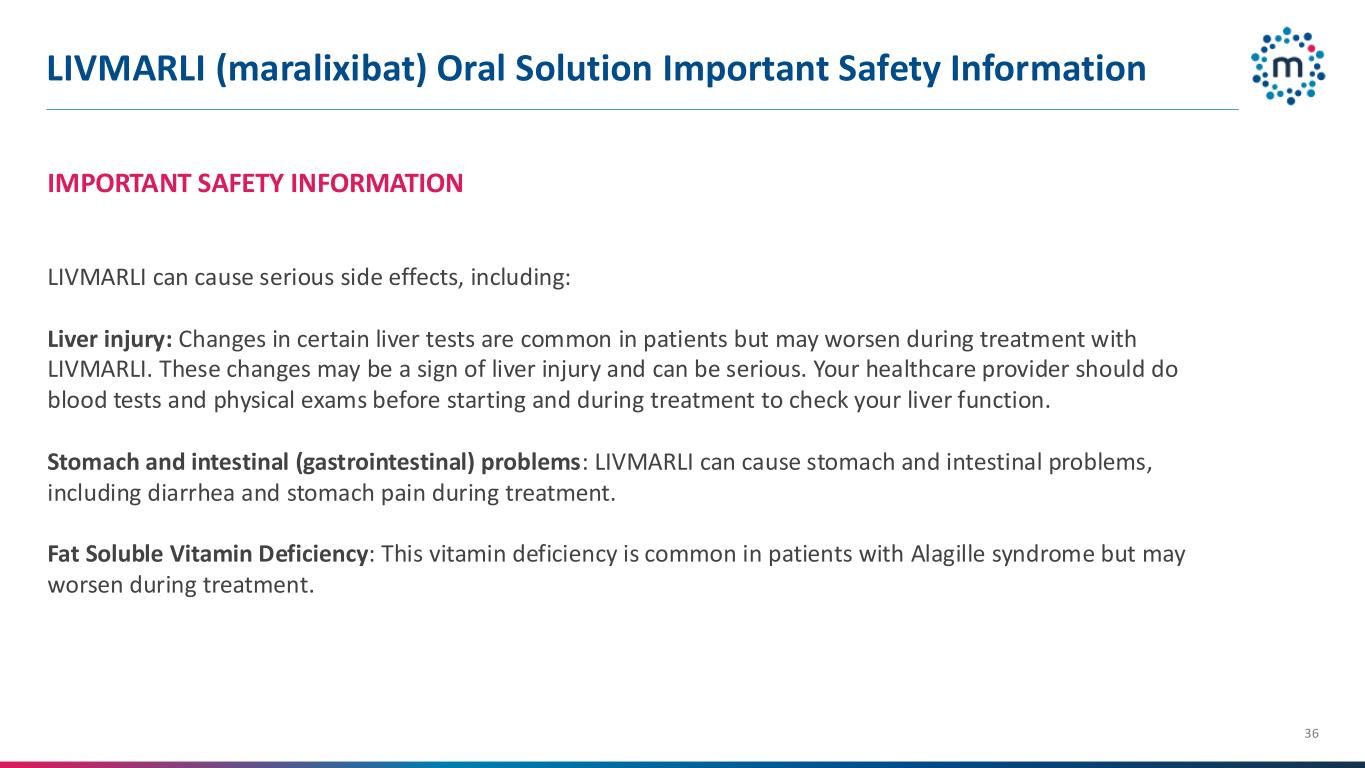
LIVMARLI (maralixibat) Oral Solution Important Safety Information 36 IMPORTANT SAFETY INFORMATION LIVMARLI can cause serious side effects, including: Liver injury: Changes in certain liver tests are common in patients but may worsen during treatment with LIVMARLI. These changes may be a sign of liver injury and can be serious. Your healthcare provider should do blood tests and physical exams before starting and during treatment to check your liver function. Stomach and intestinal (gastrointestinal) problems: LIVMARLI can cause stomach and intestinal problems, including diarrhea and stomach pain during treatment. Fat Soluble Vitamin Deficiency: This vitamin deficiency is common in patients with Alagille syndrome but may worsen during treatment.
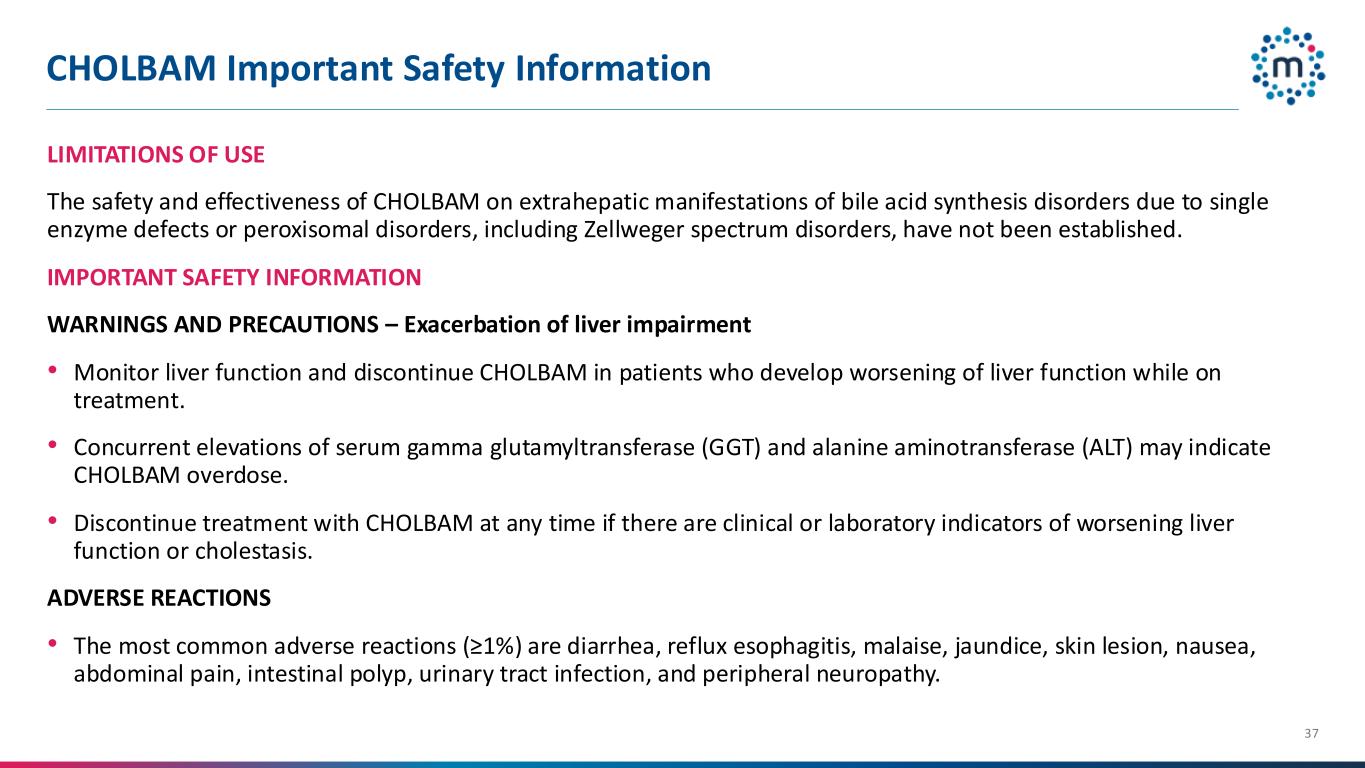
CHOLBAM Important Safety Information LIMITATIONS OF USE The safety and effectiveness of CHOLBAM on extrahepatic manifestations of bile acid synthesis disorders due to single enzyme defects or peroxisomal disorders, including Zellweger spectrum disorders, have not been established. IMPORTANT SAFETY INFORMATION WARNINGS AND PRECAUTIONS – Exacerbation of liver impairment • Monitor liver function and discontinue CHOLBAM in patients who develop worsening of liver function while on treatment. • Concurrent elevations of serum gamma glutamyltransferase (GGT) and alanine aminotransferase (ALT) may indicate CHOLBAM overdose. • Discontinue treatment with CHOLBAM at any time if there are clinical or laboratory indicators of worsening liver function or cholestasis. ADVERSE REACTIONS • The most common adverse reactions (≥1%) are diarrhea, reflux esophagitis, malaise, jaundice, skin lesion, nausea, abdominal pain, intestinal polyp, urinary tract infection, and peripheral neuropathy. 37
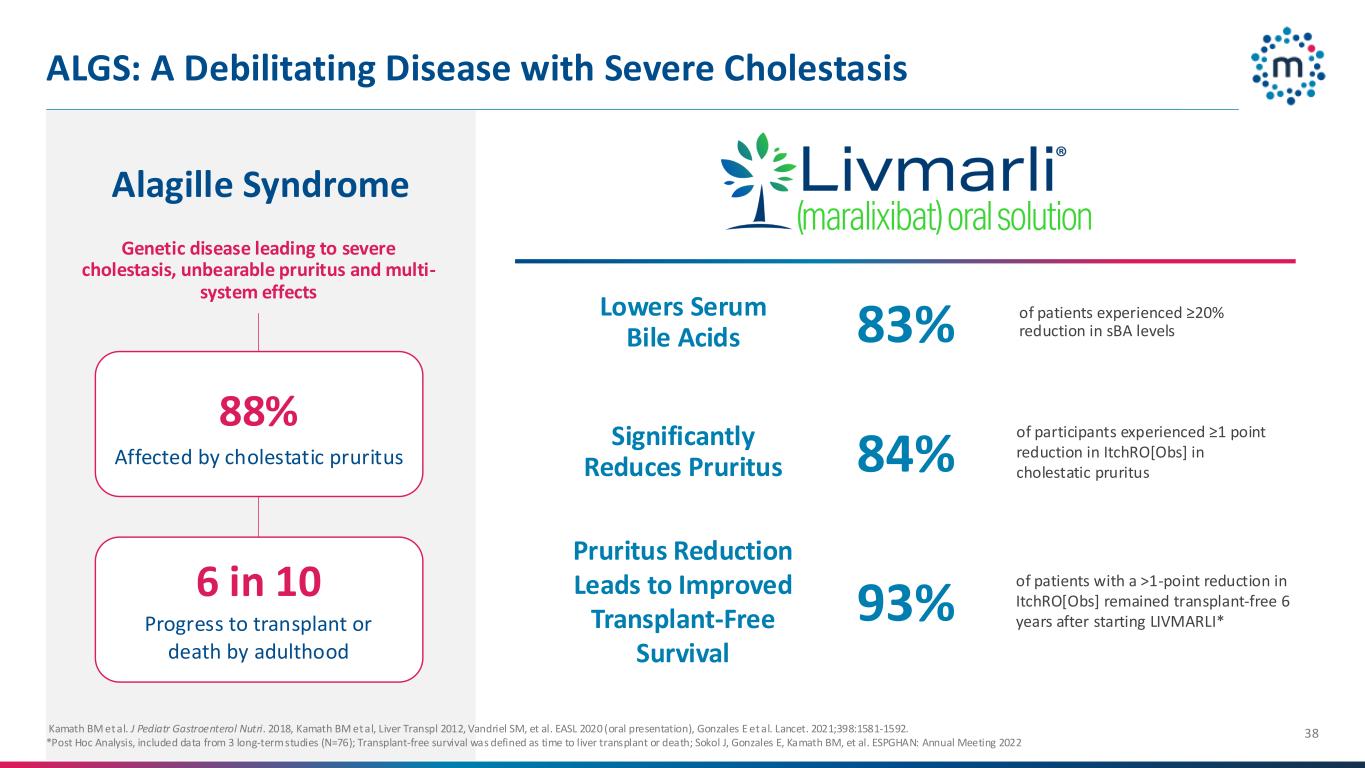
ALGS: A Debilitating Disease with Severe Cholestasis 38Kamath BM et al. J Pediatr Gastroenterol Nutri. 2018, Kamath BM et al, Liver Transpl 2012, Vandriel SM, et al. EASL 2020 (oral presentation), Gonzales E et al. Lancet. 2021;398:1581-1592. *Post Hoc Analysis, included data from 3 long-term studies (N=76); Transplant-free survival was defined as time to liver transplant or death; Sokol J, Gonzales E, Kamath BM, et al. ESPGHAN: Annual Meeting 2022 Genetic disease leading to severe cholestasis, unbearable pruritus and multi- system effects 88% Affected by cholestatic pruritus 6 in 10 Progress to transplant or death by adulthood Pruritus Reduction Leads to Improved Transplant-Free Survival Lowers Serum Bile Acids Alagille Syndrome Significantly Reduces Pruritus 84% 83% of patients with a >1-point reduction in ItchRO[Obs] remained transplant-free 6 years after starting LIVMARLI* of patients experienced ≥20% reduction in sBA levels of participants experienced ≥1 point reduction in ItchRO[Obs] in cholestatic pruritus 93%
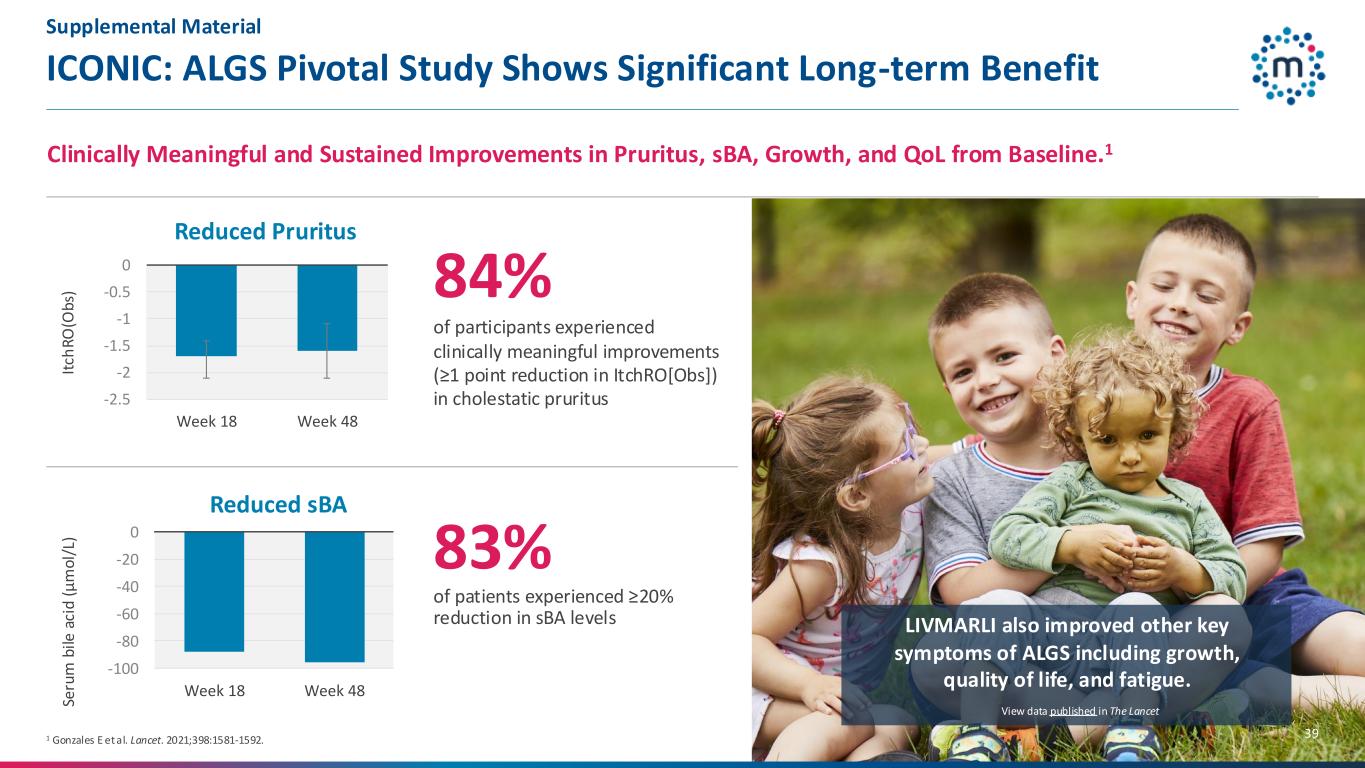
ICONIC: ALGS Pivotal Study Shows Significant Long-term Benefit 1 Gonzales E et al. Lancet. 2021;398:1581-1592. -100 -80 -60 -40 -20 0 Week 18 Week 48 Se ru m b ile a ci d ( μ m ol /L ) Reduced sBA -2.5 -2 -1.5 -1 -0.5 0 Week 18 Week 48 It ch RO (O bs ) Reduced Pruritus 84% of participants experienced clinically meaningful improvements (≥1 point reduction in ItchRO[Obs]) in cholestatic pruritus LIVMARLI also improved other key symptoms of ALGS including growth, quality of life, and fatigue. Clinically Meaningful and Sustained Improvements in Pruritus, sBA, Growth, and QoL from Baseline.1 83% of patients experienced ≥20% reduction in sBA levels View data published in The Lancet Supplemental Material 39
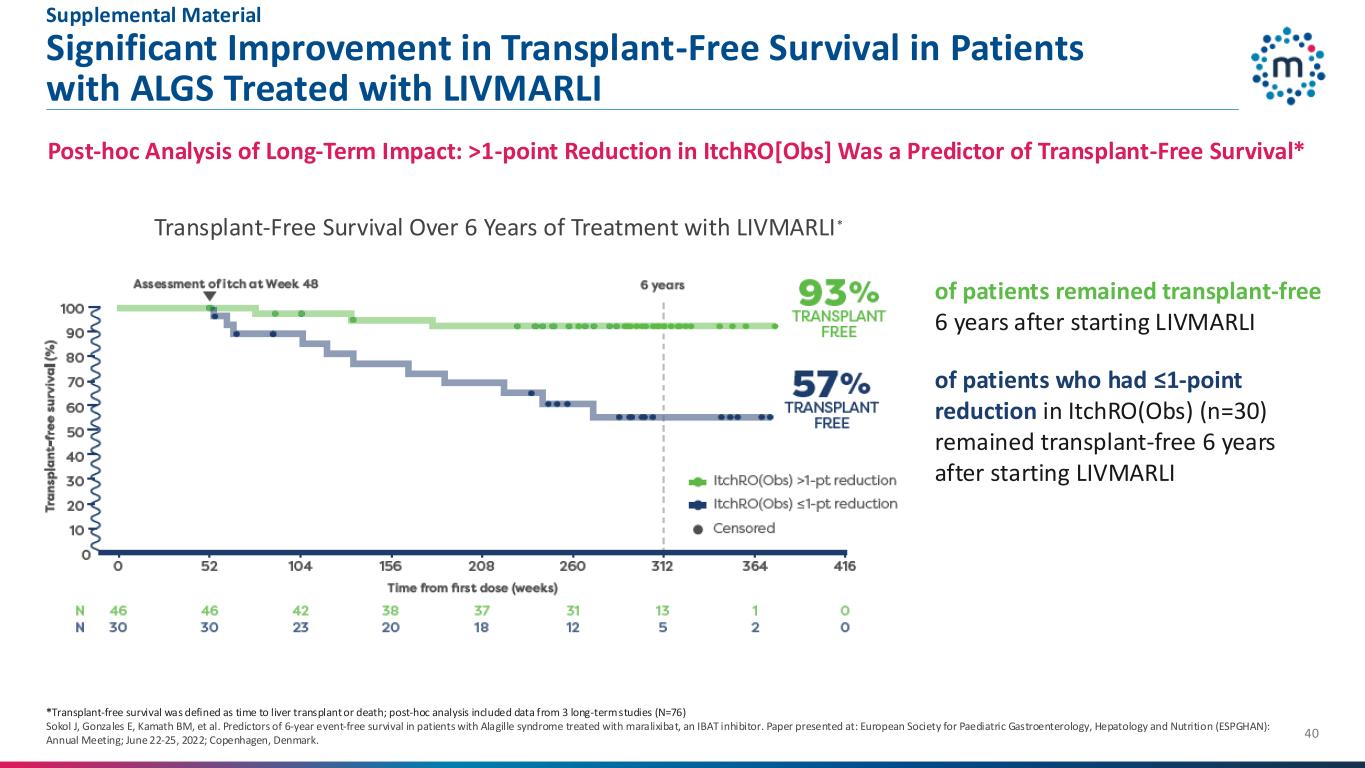
Significant Improvement in Transplant-Free Survival in Patients with ALGS Treated with LIVMARLI *Transplant-free survival was defined as time to liver transplant or death; post-hoc analysis included data from 3 long-term studies (N=76) Sokol J, Gonzales E, Kamath BM, et al. Predictors of 6-year event-free survival in patients with Alagille syndrome treated with maralixibat, an IBAT inhibitor. Paper presented at: European Society for Paediatric Gastroenterology, Hepatology and Nutrition (ESPGHAN): Annual Meeting; June 22-25, 2022; Copenhagen, Denmark. 40 Transplant-Free Survival Over 6 Years of Treatment with LIVMARLI* Post-hoc Analysis of Long-Term Impact: >1-point Reduction in ItchRO[Obs] Was a Predictor of Transplant-Free Survival* of patients remained transplant-free 6 years after starting LIVMARLI of patients who had ≤1-point reduction in ItchRO(Obs) (n=30) remained transplant-free 6 years after starting LIVMARLI Supplemental Material
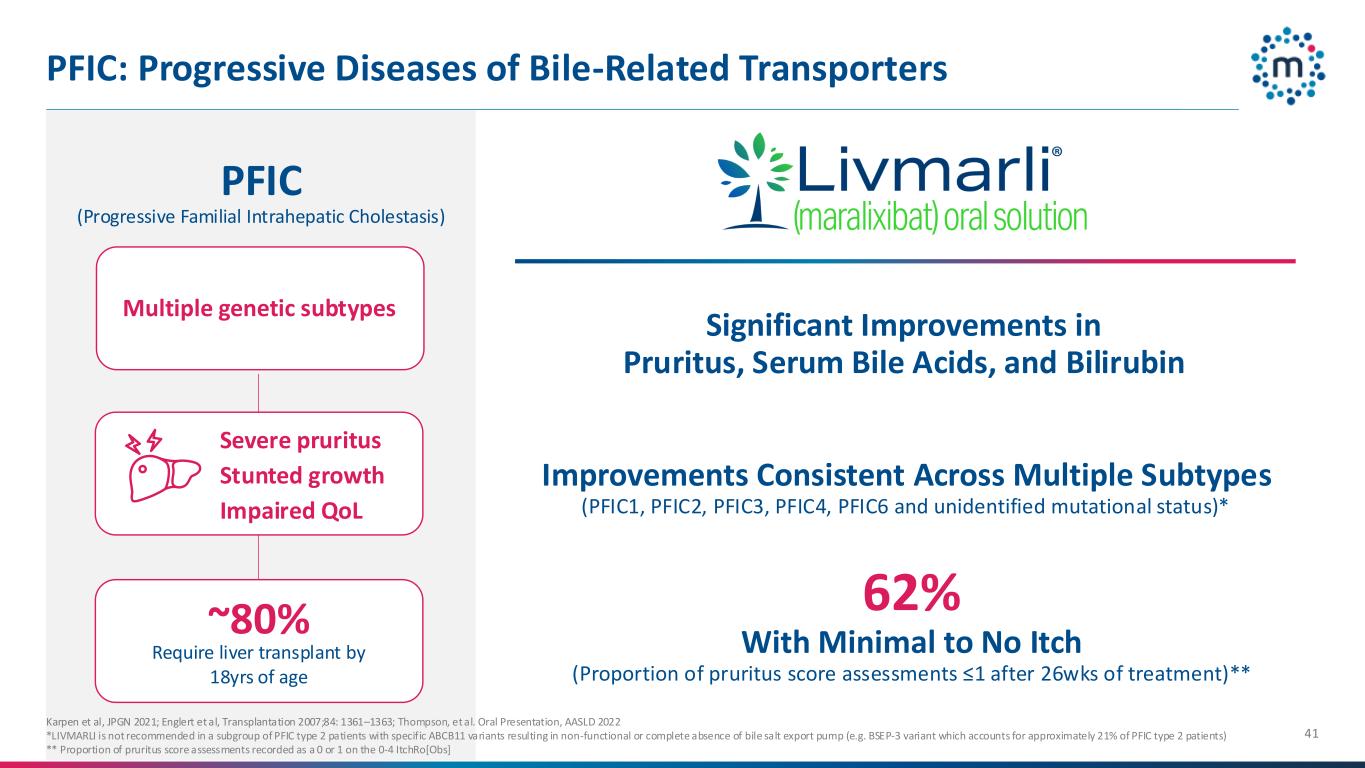
PFIC: Progressive Diseases of Bile-Related Transporters 41 ~80% Require liver transplant by 18yrs of age PFIC (Progressive Familial Intrahepatic Cholestasis) Significant Improvements in Pruritus, Serum Bile Acids, and Bilirubin 62% With Minimal to No Itch (Proportion of pruritus score assessments ≤1 after 26wks of treatment)** Severe pruritus Stunted growth Impaired QoL Improvements Consistent Across Multiple Subtypes (PFIC1, PFIC2, PFIC3, PFIC4, PFIC6 and unidentified mutational status)* Multiple genetic subtypes Karpen et al, JPGN 2021; Englert et al, Transplantation 2007;84: 1361–1363; Thompson, et al. Oral Presentation, AASLD 2022 *LIVMARLI is not recommended in a subgroup of PFIC type 2 patients with specific ABCB11 variants resulting in non-functional or complete absence of bile salt export pump (e.g. BSEP-3 variant which accounts for approximately 21% of PFIC type 2 patients) ** Proportion of pruritus score assessments recorded as a 0 or 1 on the 0-4 ItchRo[Obs]
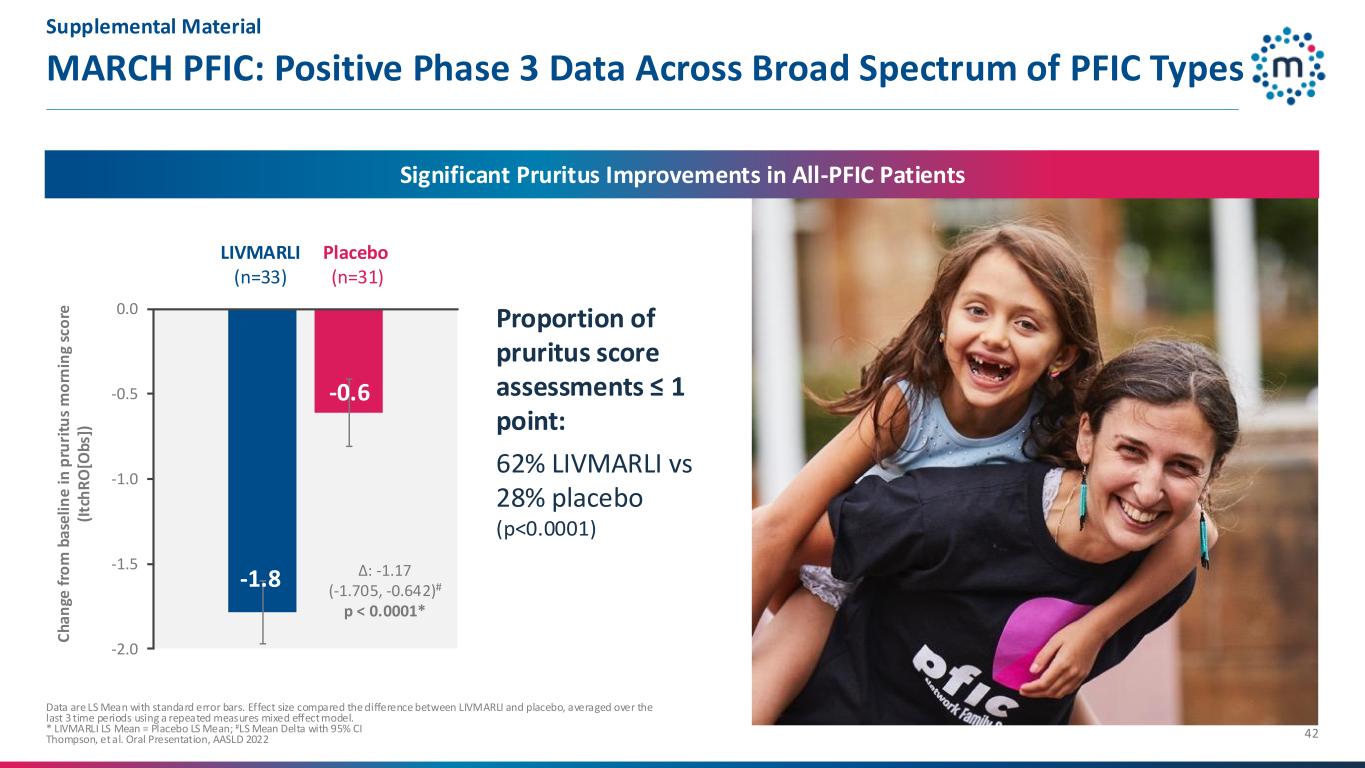
-1.8 -0.6 -2.0 -1.5 -1.0 -0.5 0.0 MARCH PFIC: Positive Phase 3 Data Across Broad Spectrum of PFIC Types Data are LS Mean with standard error bars. Effect size compared the difference between LIVMARLI and placebo, averaged over the last 3 time periods using a repeated measures mixed effect model. * LIVMARLI LS Mean = Placebo LS Mean; #LS Mean Delta with 95% CI Thompson, et al. Oral Presentation, AASLD 2022 42 LIVMARLI (n=33) Placebo (n=31) C h a n ge f ro m b a se lin e in p ru ri tu s m o rn in g sc o re (I tc h R O [O bs ]) Δ: -1.17 (-1.705, -0.642)# p < 0.0001* Proportion of pruritus score assessments ≤ 1 point: 62% LIVMARLI vs 28% placebo (p<0.0001) Significant Pruritus Improvements in All-PFIC Patients Supplemental Material
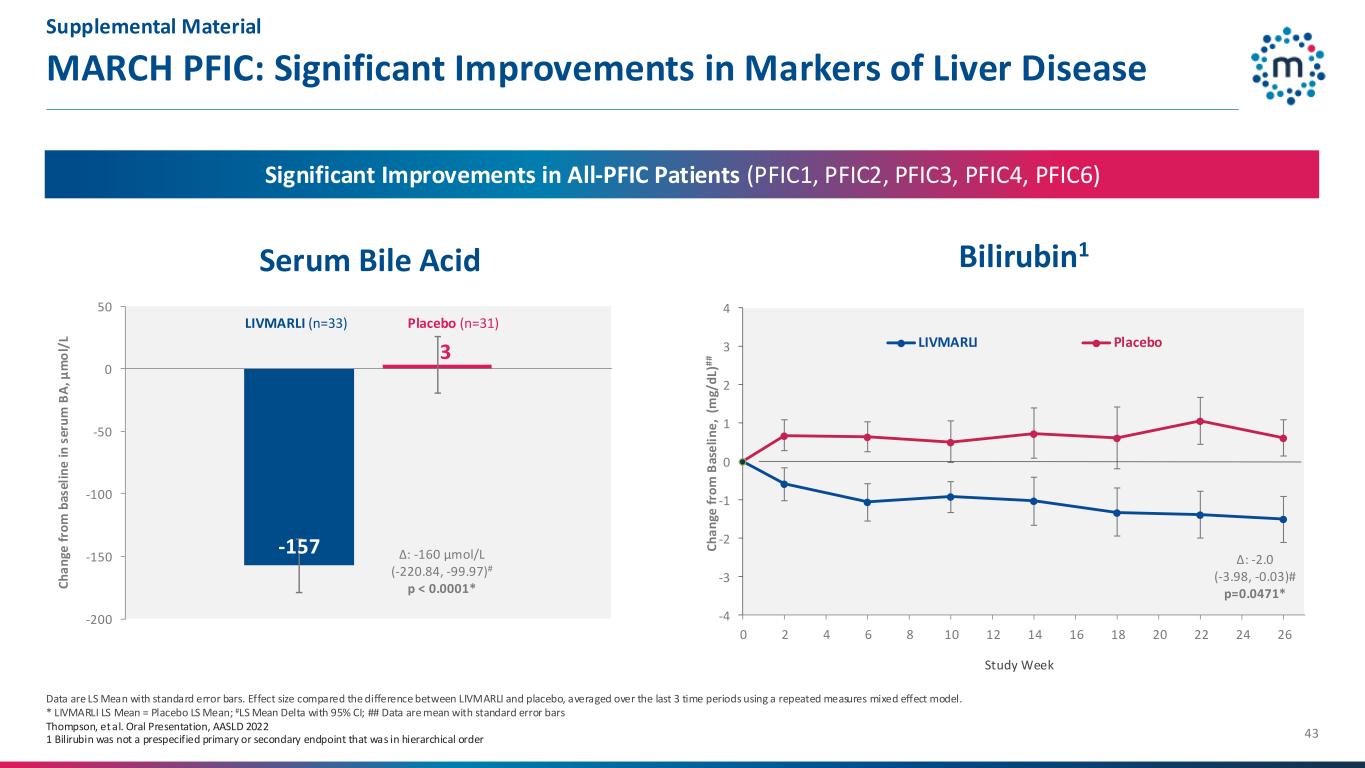
-157 -200 -150 -100 -50 0 50 MARCH PFIC: Significant Improvements in Markers of Liver Disease Data are LS Mean with standard error bars. Effect size compared the difference between LIVMARLI and placebo, averaged over the last 3 time periods using a repeated measures mixed effect model. * LIVMARLI LS Mean = Placebo LS Mean; #LS Mean Delta with 95% CI; ## Data are mean with standard error bars Thompson, et al. Oral Presentation, AASLD 2022 1 Bilirubin was not a prespecified primary or secondary endpoint that was in hierarchical order 43 3 C h a n ge f ro m b as el in e in s er u m B A , µ m o l/ L LIVMARLI (n=33) Placebo (n=31) -4 -3 -2 -1 0 1 2 3 4 0 2 4 6 8 10 12 14 16 18 20 22 24 26 Study Week LIVMARLI Placebo C h a n ge f ro m B as e li n e , (m g/ d L) # # Δ: -160 µmol/L (-220.84, -99.97)# p < 0.0001* Bilirubin1Serum Bile Acid Significant Improvements in All-PFIC Patients (PFIC1, PFIC2, PFIC3, PFIC4, PFIC6) Δ: -2.0 (-3.98, -0.03)# p=0.0471* Supplemental Material
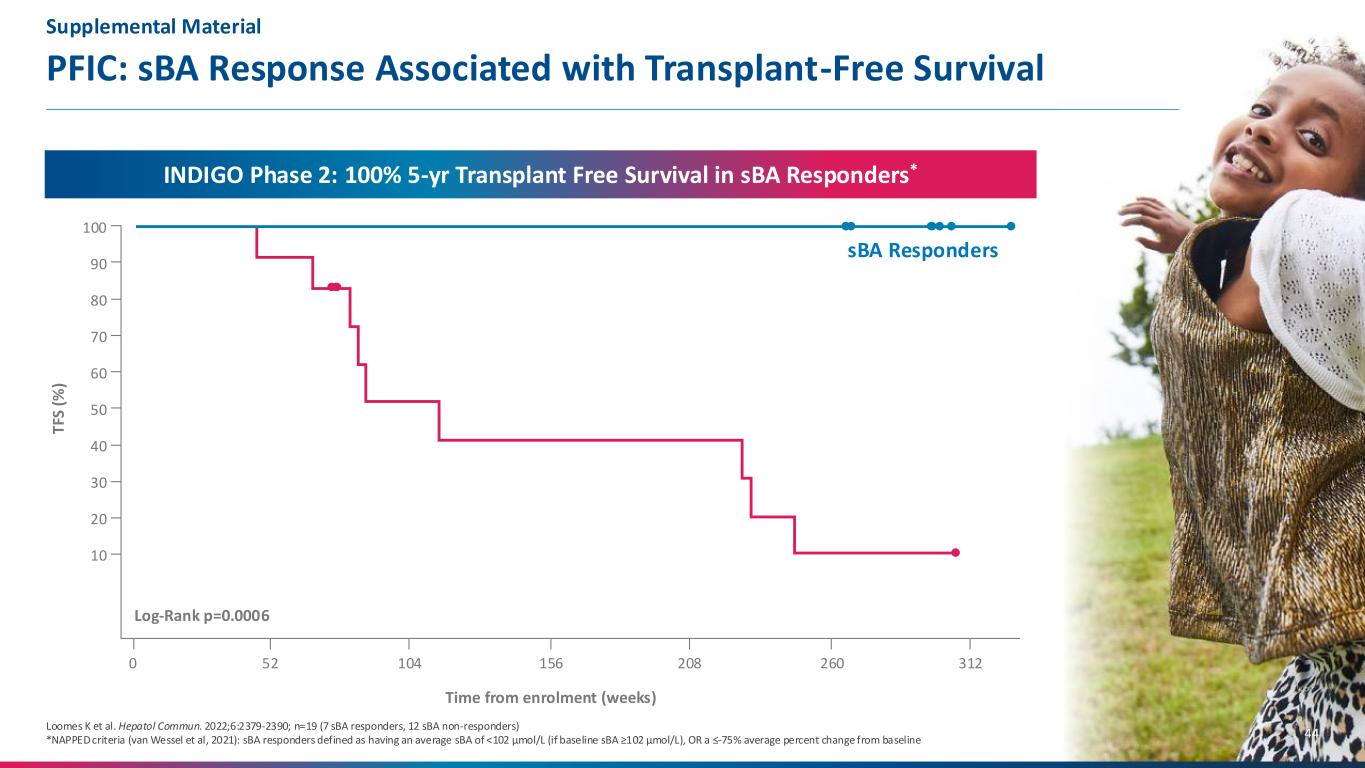
PFIC: sBA Response Associated with Transplant-Free Survival Loomes K et al. Hepatol Commun. 2022;6:2379-2390; n=19 (7 sBA responders, 12 sBA non-responders) *NAPPED criteria (van Wessel et al, 2021): sBA responders defined as having an average sBA of <102 μmol/L (if baseline sBA ≥102 μmol/L), OR a ≤-75% average percent change from baseline 44 Time from enrolment (weeks) T FS (% ) 100 60 40 20 80 10 30 50 70 90 0 52 208 260 312104 156 Log-Rank p=0.0006 sBA Responders INDIGO Phase 2: 100% 5-yr Transplant Free Survival in sBA Responders* Supplemental Material

RESTORE Phase 3: Potentially NDA enabling for CTX, Orphan Exclusivity 45 RESTORE Phase 3 Double-blind placebo controlled cross-over withdrawal study Primary Endpoint • Change from baseline in urine total 23S-pentol (bile alcohol) Secondary Endpoints • Change from baseline in plasma 7αC4 • Change from baseline in plasma cholestanol • Proportion of patients requiring rescue medication All endpoints assessed at the end of double-blind periods Follow-up (30 days) 8wks 4wks* PBO 4wks* Open Label chenodiol 8wks N=13 chenodiol chenodiol PBOOpen Label chenodiol Open Label chenodiol Open Label chenodiol Elevated Levels of Cholestanol Drive Symptomatic Burden and Progression in CTX chenodiol = CDCA *Rescue chenodiol available as needed if symptoms occur or lab values are out of the expected range for patients receiving chenodiol or PBO Double-Blind Baseline defined as the last measurement prior to dosing on Day 1 for Double-Blind period 1 and Day 85 for Double-Blind period 2 THE FIRST AND ONLY PHASE 3 PLACEBO-CONTROLLED STUDY IN CTX Supplemental Material
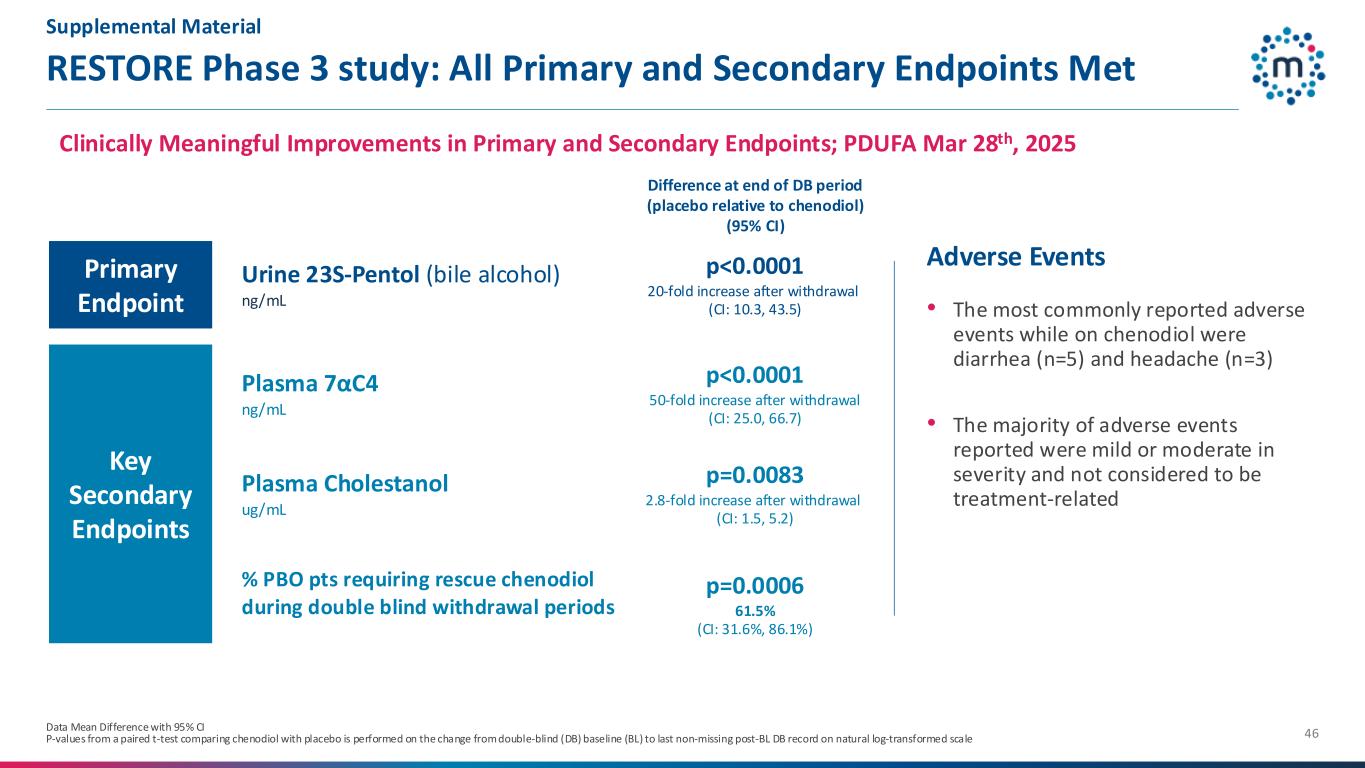
RESTORE Phase 3 study: All Primary and Secondary Endpoints Met 46 Data Mean Difference with 95% CI P-values from a paired t-test comparing chenodiol with placebo is performed on the change from double-blind (DB) baseline (BL) to last non-missing post-BL DB record on natural log-transformed scale Adverse Events • The most commonly reported adverse events while on chenodiol were diarrhea (n=5) and headache (n=3) • The majority of adverse events reported were mild or moderate in severity and not considered to be treatment-related Urine 23S-Pentol (bile alcohol) ng/mL p<0.0001 20-fold increase after withdrawal (CI: 10.3, 43.5) Plasma 7αC4 ng/mL p<0.0001 50-fold increase after withdrawal (CI: 25.0, 66.7) Plasma Cholestanol ug/mL p=0.0083 2.8-fold increase after withdrawal (CI: 1.5, 5.2) % PBO pts requiring rescue chenodiol during double blind withdrawal periods p=0.0006 61.5% (CI: 31.6%, 86.1%) Clinically Meaningful Improvements in Primary and Secondary Endpoints; PDUFA Mar 28th, 2025 Difference at end of DB period (placebo relative to chenodiol) (95% CI) Primary Endpoint Key Secondary Endpoints Supplemental Material

Intellectual Property Overview
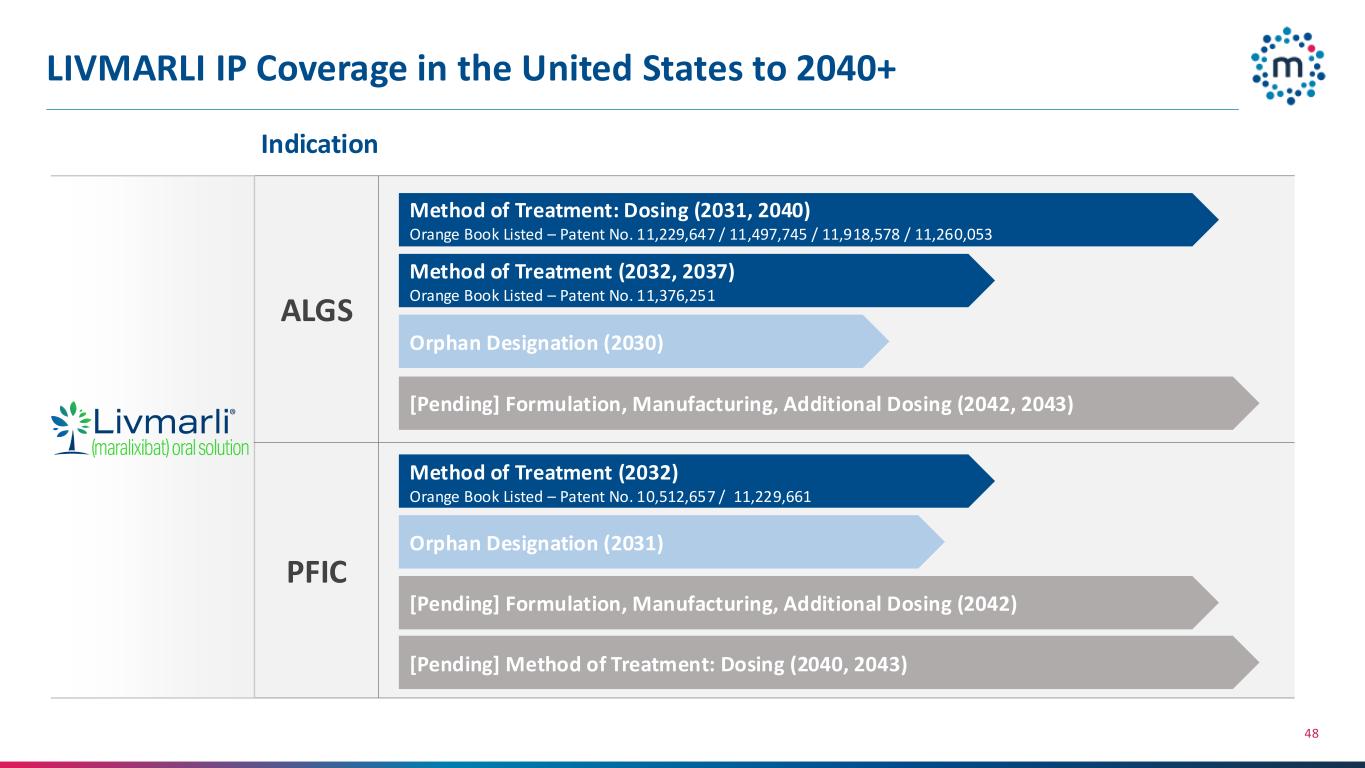
ALGS PFIC LIVMARLI IP Coverage in the United States to 2040+ 48 Method of Treatment: Dosing (2031, 2040) Orange Book Listed – Patent No. 11,229,647 / 11,497,745 / 11,918,578 / 11,260,053 Method of Treatment (2032, 2037) Orange Book Listed – Patent No. 11,376,251 [Pending] Method of Treatment: Dosing (2040, 2043) Method of Treatment (2032) Orange Book Listed – Patent No. 10,512,657 / 11,229,661 Orphan Designation (2030) [Pending] Formulation, Manufacturing, Additional Dosing (2042, 2043) [Pending] Formulation, Manufacturing, Additional Dosing (2042) Orphan Designation (2031) Indication
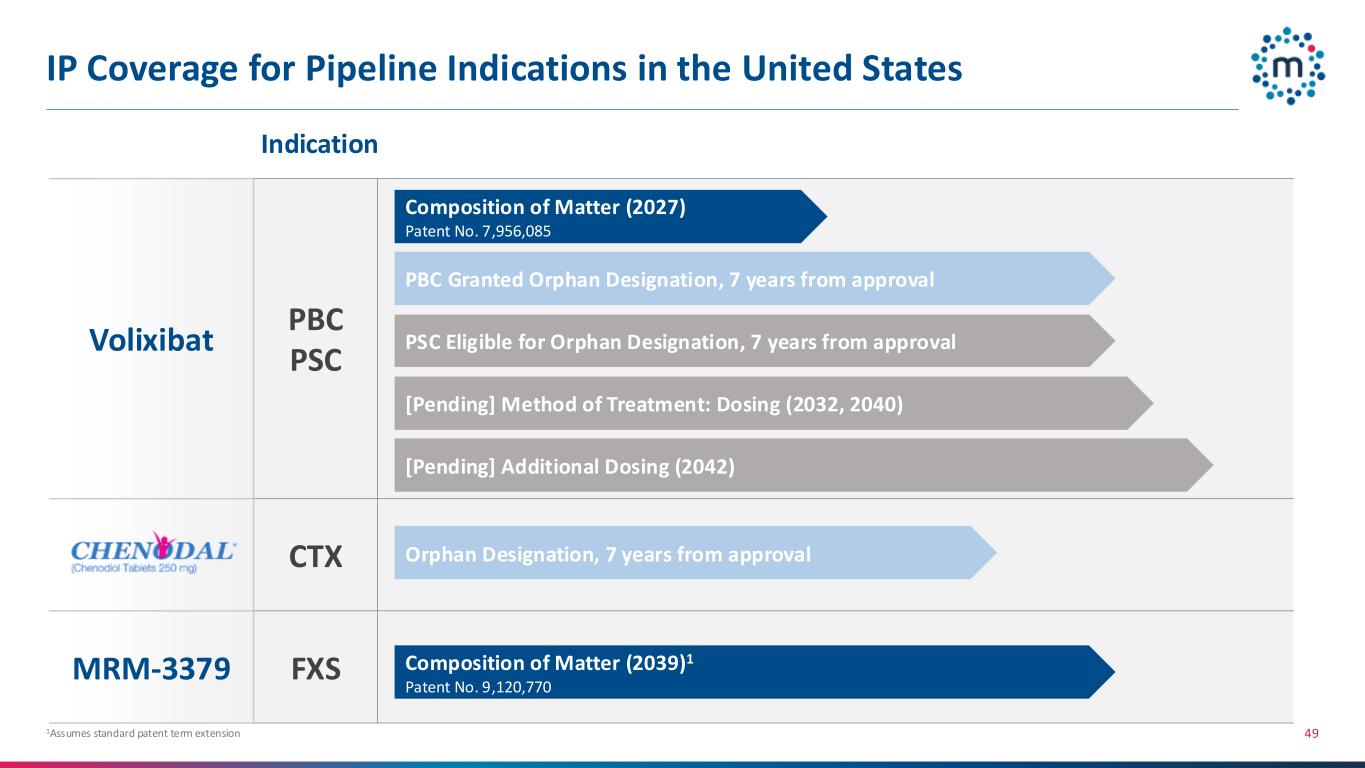
Volixibat PBC PSC CTX MRM-3379 FXS IP Coverage for Pipeline Indications in the United States 491Assumes standard patent term extension [Pending] Additional Dosing (2042) [Pending] Method of Treatment: Dosing (2032, 2040) Orphan Designation, 7 years from approval Composition of Matter (2027) Patent No. 7,956,085 PBC Granted Orphan Designation, 7 years from approval Indication Composition of Matter (2039)1 Patent No. 9,120,770 PSC Eligible for Orphan Designation, 7 years from approval
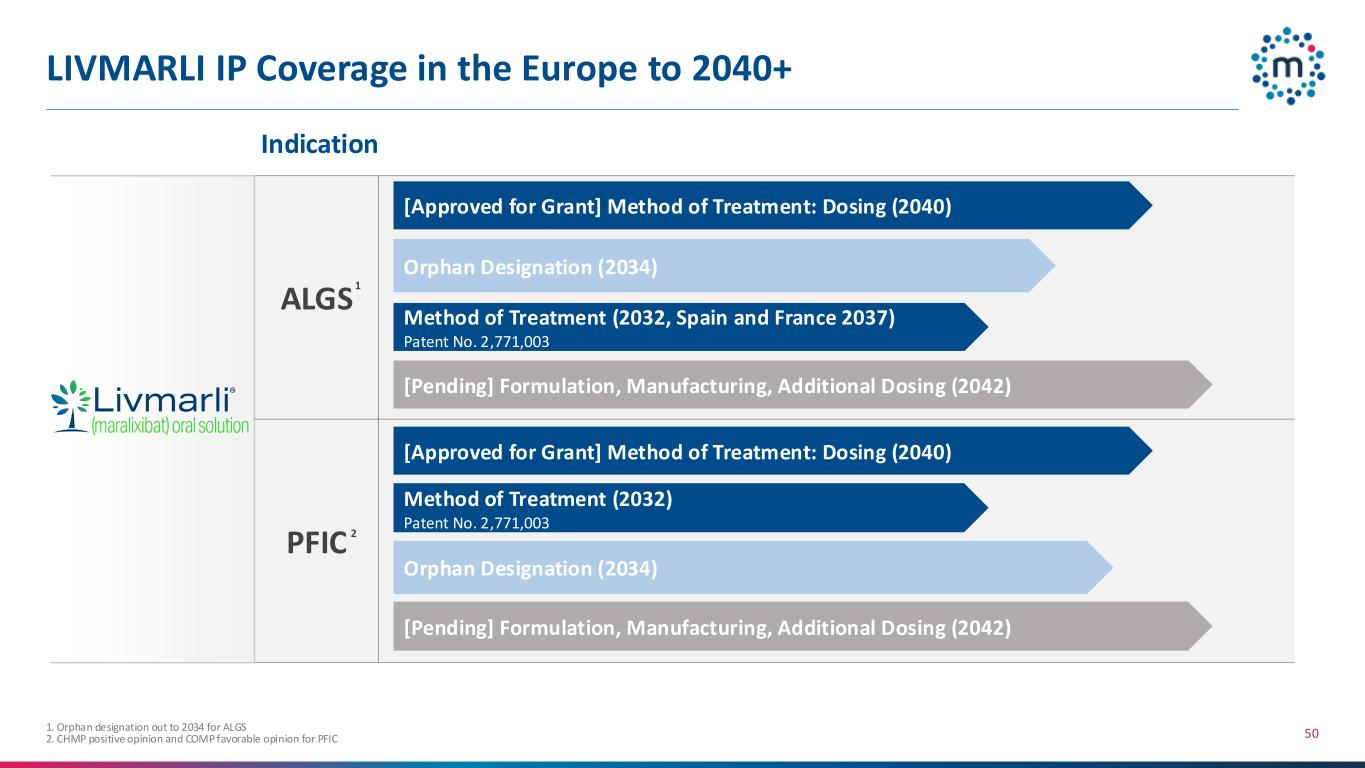
LIVMARLI IP Coverage in the Europe to 2040+ 50 Indication Method of Treatment: Dosing (2031, 2040) Orange Book Listed – Patent No. 11,229,647 / 11,497,745 / 11,918,578 / 11,260,053 Method of Treatment (2032) Orange Book Listed – Patent No. 11,376,251 Method of Treatment (2032) Orange Book Listed – Patent No. 10,512,657 / 11,229,661 Orphan Designation (2030) [Pending] Formulation, Manufacturing, Additional Dosing (2042, 2043) ALGS PFIC [Pending] Formulation, Manufacturing, Additional Dosing (2042) [Approved for Grant] Method of Treatment: Dosing (2040) Method of Treatment (2032, Spain and France 2037) Patent No. 2,771,003 [Approved for Grant] Method of Treatment: Dosing (2040) Method of Treatment (2032) Patent No. 2,771,003 [Pending] Formulation, Manufacturing, Additional Dosing (2042) Orphan Designation (2034) Orphan Designation (2034) 1. Orphan designation out to 2034 for ALGS 2. CHMP positive opinion and COMP favorable opinion for PFIC 1 2
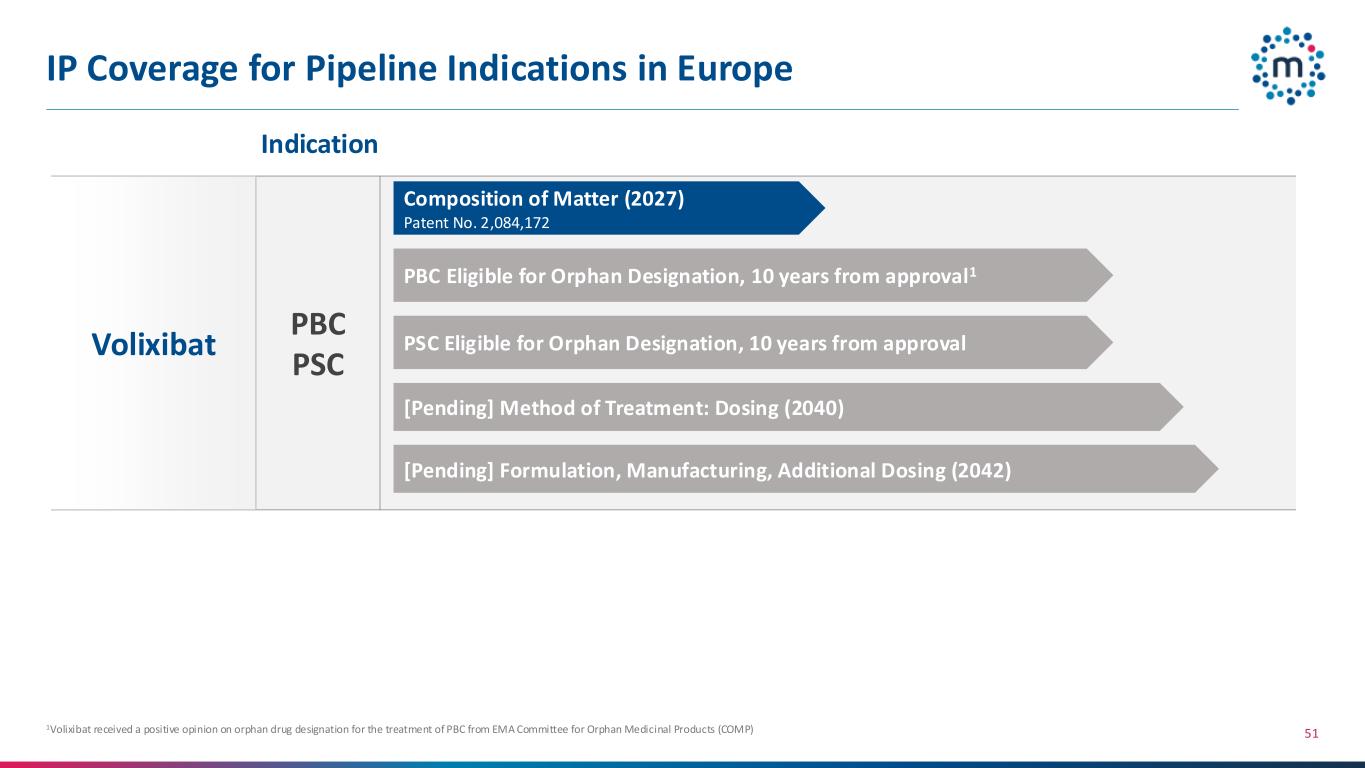
IP Coverage for Pipeline Indications in Europe 51 Method of Treatment: Dosing (2031, 2040) Orange Book Listed – Patent No. 11,229,647 / 11,497,745 / 11,918,578 / 11,260,053 Method of Treatment (2032) Orange Book Listed – Patent No. 11,376,251 [Pending] Method of Treatment: Dosing (2040, 2043) Orphan Designation (2030) [Pending] Formulation, Manufacturing, Additional Dosing (2042) Volixibat PBC PSC [Pending] Method of Treatment: Dosing (2040) Composition of Matter (2027) Patent No. 2,084,172 [Pending] Formulation, Manufacturing, Additional Dosing (2042) PSC Eligible for Orphan Designation, 10 years from approval Indication 1Volixibat received a positive opinion on orphan drug designation for the treatment of PBC from EMA Committee for Orphan Medicinal Products (COMP) PBC Eligible for Orphan Designation, 10 years from approval1


















































